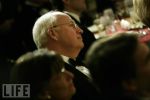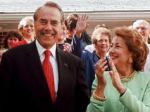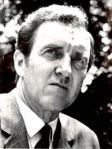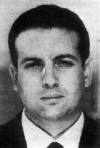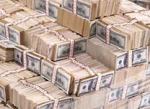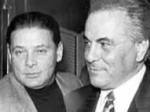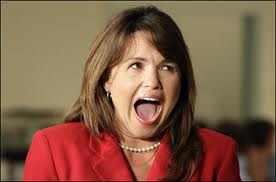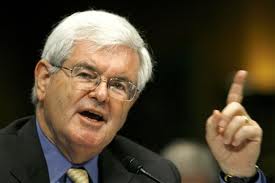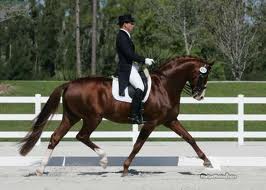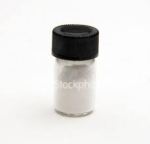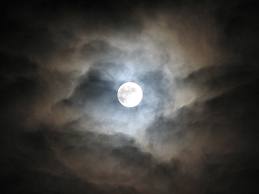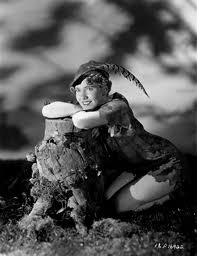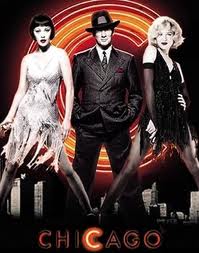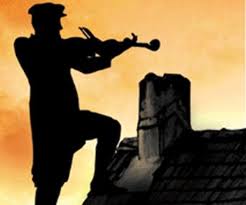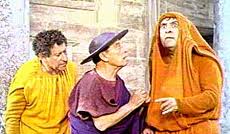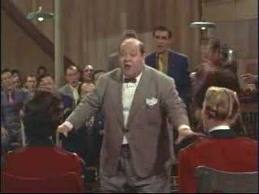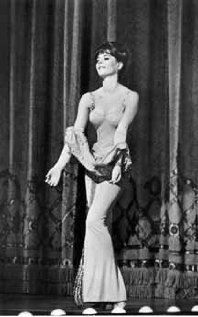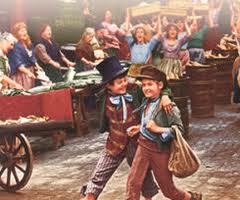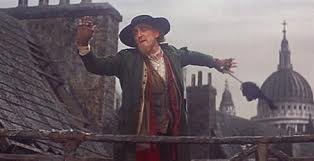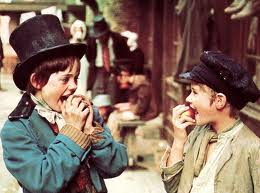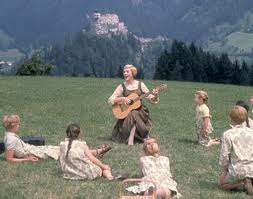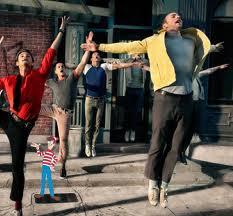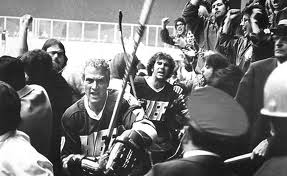LULA AND CHRISTY GO TO TAMPA – An Uber Adventure

LULA AND CHRISTY GO TO TAMPA
An Uber Adventure
By Shaun Costello
Friday afternoon began without any surprises. I headed for my car carrying a bag of garbage to take to the community compactor, and a grocery list for the day’s shopping. When I got behind the wheel, I tapped the Uber App on my smart phone, which would connect me, through the GPS system, with Uber’s network. I had been driving an Uber cab for about two weeks, and was anxious to get some trips because last week I had gotten no fares at all. After dropping off the trash, I got back in my car to the sound of Uber’s trip signal. On the phone’s screen a circle was flashing on the GPS map, and my little Samsung Galaxy was beeping its heart out. A trip – just what I needed. Normally, the screen on the Uber App would provide the address and name of the passenger, the destination and the distance. But my screen was too dark to see any detail in daylight. Uber’s software was not yet fully engaged. So I let the voice on Uber’s navigation system guide me to my passenger. The Uber software is pretty glitchy, and seldom works as advertised, and Uber’s tech support is defensive and relatively unhelpful. As an Uber driver you’re pretty much on your own to wrangle your way through Uber’s software jungle, and somehow make it work.
The navigator’s voice guided me over the Peace River Bridge to downtown Punta Gorda, and a few quick turns took me to the front of one of the town’s waterfront hotels. I parked under the hotel’s portico and waited. No one approached the car, and the navigator’s voice kept squawking about another left turn and one hundred feet to the destination. I slowly made my way around the parking lot, and, sure enough, there was a second entrance. As I came to a stop, my phone’s screen lit up and told me I had arrived, but there was still no passenger’s name or destination provided. Not that I cared. I had a fare, and like Travis Bickle, I was prepared to take them wherever they wanted to go.
There was a substantial pile of luggage outside the door to the hotel. Four large hard bags, with handles and wheels, and several smaller bags, including several plastic shopping bags which were overflowing with contents. Standing behind the pile of luggage were two thin women, I would guess to be in their mid-forties, puffing on cigarettes and intensly babbling at each other. I got out of my car and asked them if they had ordered an Uber cab. The luggage might mean an airport run, which meant fifty bucks in my pocket, so I’m sure I had a smile on my face. At first they were a bit baffled by the car and the luggage, and how to fit all this into my little Honda Civic, and they shuffled their feet a bit, and puffed on their cigarettes. As we began to stuff my little trunk with their baggage, I asked if they were headed to the Airport. ‘No honey”, said the taller of the two in a seriously southern accent , “We’re goin’ to Tampa. A long trip today, sugar.” Tampa – that was over a hundred miles north, good news for this eager Uber driver.
After packing my little Honda’s trunk to its absolute limit, and the girls agreeing without complaint, to not smoke in my car, they crammed themselves and their overflowing shopping bags into the back seat, as I wiped the Uber App’s ‘Begin the Trip” bar to officially start the journey. They would introduce themselves as Lula and Christy. Two southern babes who had found themselves abandoned in Punta Gorda, Florida.
As we made our way toward I75 for the trip north to Tampa, they began to tell me their story, which, of course, was obvious from the get go. Lula, the taller and older of the two was from Memphis, and young Christy was from Biloxi Mississippi. Lula said she used Uber cabs all the time because she traveled so much, but she was vague about the nature of her travels. Christy seemed to be along for the ride. It seems they met this guy, which is, of course, how all stories like this one begin. They met him in an airport, although it was difficult from their babbling to understand where exactly, in the terminal cocktail lounge, waiting for a flight to Orlando. The guy bought them drinks, and after a while, began to persuade them to skip Orlando and come with him to Punta Gorda. “Orlando’s for losers”, he told them. “Come with me. My car’s in the lot at the Fort Myers airport. We’ll fly there and I’ll drive you to Punta Gorda.” He told them he would put them up in the best hotel in town and rent them a car. They would have the time of their lives. He would pay for everything. After several drinks, their Punta Gorda adventure began sounding more and more appealing. So, they changed their flight, and joined their new and generous friend on his journey to Fort Myers.
The whole business began to unravel as they checked in to the hotel in Punta Gorda. It seems that their new friend’s credit cards were maxed out. He told them that it was no problem. He had other cards at home and he would bring them over in the morning to pay for their room and take care of that rental car he had promised them. Although they were not specific about what took place in their hotel room that night, I think it’s safe to assume that a menage et troix of some kind was the order of the evening. They awoke with hangovers, their new friend long gone, having made his escape during the night. When they attempted to call him they found that his cell phone was out of order. He had never mentioned his last name. They had no way to find him. So, here they were – a couple of southern babes with serious hangovers, out two hundred bucks for the hotel room, in a strange little town about a million miles from nowhere. Lula had been to Tampa several times and liked it. She told her hungover companion that they would go to a waterfront hotel she knew in Tampa, and just try to forget the whole unpleasant episode. How would they get there? Lula had an Uber account.
Enter yours truly, dear reader, now on I75, headed north with a packed car, and two hungover and frisky women, who had decided to forget their misfortune and seize the day. We had barely put ten miles on the odometer before two fleshy objects revealed themselves on the arm rest between the two front seats – Two bare feet, containing ten toes, and two toe rings. Lula, who was sitting behind me, had placed her right foot on the arm rest, along with Christy’s left. I have to admit that they were attractive feet, and to thinking that this was the most promising Friday I had spent in a while. After a moment or two of silent anticipation, Lula pleasantly demanded to know which of the two feet were sexier. Was I being tested? Seduced? What exactly was happening here?
“C’mon now, honey. Who’s got better feet? You know you’re gonna like one more than the other. I think mine are pretty sexy, but if you like Christy’s, I’m OK with that. C’mon honey, you pick ‘em.”
The ten toes seemed engaged in some kind of choreographed wiggle routine, perhaps to help me decide. Was there a candid camera hidden somewhere in their luggage? All I knew is that I was up a hundred bucks for the long distance Uber trip, and presently engaged in an outrageous flirtation with two whacky women who had been abandoned in my neighborhood. I tried, of course to be “Solomon-like” in making any comparison. I told the girls that each foot had a different shape and that both were attractive in different ways. I said that I found both feet to be appealing, and that, if I came upon either of them in the course of an evening’s activities, that I would certainly create an inventive and satisfying use for them. Silence now. No response from the girls until I heard Christy telling Lula no to Patty Cakes.
“I don’t want to play Patty cakes.”
“C’mon now Christy honey, you know you want to.”
“No I don’t. No Patty cakes”
“Yesterday you played. You said you loved playing Patty Cakes.”
“No, I don’t want to. You can’t make me.”
“Suit yourself, Chisty honey, but you know you want to.”
During the Patty Cake exchange, the two bare feet disappeared from comparative consideration, my carefully crafted comparison evidently ignored. But the inquisition continued. Inquiring minds wanted to know.
It was Christy this time. “What do you think makes me horny, honey?”
The acoustics in my Honda favored road noise over back seat dialogue, so Chisty’s question seemed muffled, and my response was idiotic. “Christy, you want to know what I think makes you a horny honey?”
“No, no, no….You’re the honey – I’m just horny. I asked you, ‘What do you think makes me horny, honey?’ So, what do you think? C’mon now, guess.”
Were they just messing with me? I wasn’t sure. This was now far outside my very limited Uber experience..
“Christy, I don’t know you well enough to know what makes you horny. I know that you have an attractive left foot, and that some guy played some havoc with you both. That’s about all I know.”
“Drinkin’”
“I’m sorry?”
“Drinkin’. Drinkin’ makes me horny as hell. The more I drink the hornier I get. You like drinkin’?”
“Sure, I mean, I guess.”
“I bet I could drink you under the table.”
“I’m sure you could, Christy. At my age, I don’t really do much high-volume drinking anymore. I’m too old for that kind of thing.”
“Nonsense. You’re not old at all. Younger men are stupid. I can’t tolerate ‘em. I like older men. Wisdom comes with age, don’t you know that? Hey, what sign are you, anyway?”
This conversation peaked with the foot comparisons, and had gone steadily downhill since the introduction of the Patty Cakes. “Capricorn, Christy. I’m a Capricorn.”
“Capricorn. That’s the goat. I like that. You know, I’ve learned a lot from hangin’ with older men. Older guys know stuff. Older guys have taught me everything I know about sex. And I know a shit-load about sex, I’ll tell you. A mega shit-load. “
Lula chimed in. “She sure does. Knows everything there is to know. Christy’s a fuckin’ encyclopedia, pardon my French, in the sex department.”
Was there a hidden microphone recording all of this? Adjectivally speaking, ‘hoodwinked’ would best describe how I felt at this moment. This couldn’t really be happening, could it? We were approaching the Sunshine Bridge on I75 and there was a scenic rest stop on the water, so I exited the highway, and pulled into the parking lot. I told the girls I was giving them a bathroom and cigarette break, and they squealed with delight. They needed the trunk opened so that they could rearrange some of their luggage, and for the next half hour, all of their bags were taken out of the trunk, and emptied on the pavement. They seemed to be taking the contents of each bag and placing it in the bag next to it, which had been emptied for this purpose, the contents now spread all over the ground. They sat in the midst of this mini-mountain of their possessions, babbling incomprehensibly, and passing cell phones back and forth. Christy had two, and Lula three, and they began to send text messages to unsuspecting recipients. The babbling had stopped now, and their thumbs were ablaze, texting away – using all five cell phones at once – passing them back and forth in an orgy of tele-communication.
If I were a normal taxi driver, I think I would be concerned at this point. Had these two escaped from psychiatric incarceration somewhere? Did they really have the money to pay for this very expensive ride? But with Uber, the minute a customer requests a ride, a hold is put on their credit card for the approximate amount of the fare. There was no way that I was not getting paid for this adventure. But this was time consuming, and I had to crack the whip. I told them that if a state trooper came by, we might get a ticket for littering, and to please get all of this stuff back in the trunk. They reacted surprisingly well, like naughty children who knew they had overreached, and began to fill the trunk with their newly rearranged possessions. We had now been in this parking lot for an hour, and neither Lula nor Christy had peed or had a cigarette. It was time to do both and get on with the trip.
I took advantage of the girls’ bathroom visit by activating the navigation system on the Uber App, which immediately lit up and started squawking directions. I now knew that I was getting paid for this bizarre endeavor, and I had directions to our destination, which made me feel better, since the girls were vague about knowing how to get where they were going. As we began to ascend the towering Sunshine Bridge, Christy spoke up mournfully, “When my Mama drew her last breath, a tear trickled down her cheek, like to break my heart right then and there.” Well, this was certainly a conversational game changer. Not to be outdone in the ‘last breath’ department, Lula answered, “When my Gramma drew her last breath, it was so soft you could barely hear it, I loved my Gramma.” Without skipping a beat, Christy responded, “When my Papa drew his last breath, it sounded like the last note in a sad song.”
Lula was now fully engaged. “When my Uncle Abner drew his last breath, it was as crackly as could be. Sounded like a chain saw.”
“Last breaths can’t be crackly, Lula. The good Lord made last breaths to be soft and soothing, like angel’s feathers.”
“You never met Uncle Abner. Every time that man opened his mouth it sounded like a chain saw. Like to drive Aunt Esther to drink. Not that she needed much help.”
The ‘last breath’ competition continued for a few more minutes, before the girls remembered that I was in the car. At least Christy remembered.
“Hey there, you don’t have to go back tonight , do you? I got plans for you, mister. I’m gonna drink you under the table. Hey, you’re not married or nothin’, are you?”
I told Christy I was divorced and she squealed, “Eeeeeeehaaaa…..I bet you’re not as innocent as you look. I bet you’re a guy who’s constantly on the prowl, lookin’ to meet up with someone just like me. Aint that true? C’mon, fess up, you’re a horny bugger, aint you? I’m gonna drink your cute little ass right under that table. Then we’ll see what’s what. I don’t take no for an answer, do I, Lula?”
“Nope, she sure don’t. You’ll be stayin’ with us tonight. We’ll get a room, and when the fun starts, the sky’s the limit.”
For purpose of disclosure, I have to admit to being both amused and tempted when those two feet suddenly and playfully appeared on the arm rest. But now, that seemed so long ago. I did not feel that these girls put me in danger in any way, but we were now three and a half hours into this trip, with at least another half hour to our destination, and there was the return trip to consider. Spending the night in a hotel room with Lula and Christy was not on my bucket list. I did not say no, however. I thought it prudent to play them along, and wait for the right moment to make a graceful exit.
We were now in bumper to bumper rush hour traffic, and the navigation system’s voice was giving me different directions than Lula, who had told me she had stayed in this hotel several times. She said that she might have given Uber the wrong street address. Uber’s navigation system was extremely precise, and if she address had been off by a single digit in the street number, the directions to the address would differ substantially. Lula had said turn right when Uber said left, and since she had been there before I followed Lula. We made a few more turns until we would up in a parking lot a few hundred yards from the hotel. Lula said to stop here. That someone was meeting them here, and they would decide on where to stay when he arrived. This was a new wrinkle in their story. Someone was meeting them. The Uber App was telling me that we were 300 feet from our destination, and until that destination was reached, the trip could not be concluded, which meant of course, that I would not be paid. I had to get these girls out of my car, and their ton of luggage out of my trunk as gently as possible, and drive that 300 feet.
Lula and Christy were now sitting on the pavement next to my car, all five cell phones actively engaged in another texting orgy. I mentioned to Lula that she should call her friend rather than texting him, since he was obviously on his way, and driving a car. Christy responded that Lula didn’t talk on phones, she only texted. My Samsung kept squawking about the 300 feet to the destination, and I tried, as gently as possible, to explain that if my car did not travel the 300 feet, that Uber would not pay me. They responded well to this information, and began removing bags from the trunk, while continuing to text to God only knows whom. But as the bags were placed on the pavement, their contents began being switched, just as they had at the rest stop. Distracted by their texting, the girls were removing half the contents of the bags, leaving the stuff strewn all over the pavement. This is where Lula had said that her friend was meeting them – right here in this parking lot.
Just as they had done at the rest stop, Lula and Christy were now sitting in the midst of a mountain of clothes, various and sundry bathroom items, and odd electronic devices, texting away on all five cell phones. I announced that I was going to drive that final three hundred feet to complete the trip, so that I would be paid. They grunted a vague acknowledgement, but pretty much ignored me. So that’s where I left them, in the middle of a now-trashed parking lot, sitting on the pavement in the midst of all their worldly possessions, texting their hearts out, seemingly unaware of my leaving, or of anything else for that matter. As I got back in my car, they didn’t look up. I watched them in the rear view mirror as I drove away, hoping that they might wave, but they were in another world entirely, and quite oblivious to mine.
By the time I reached home, eight hours had elapsed since my smart phone lit up with the Tampa trip. As a purely business venture I consider these eight hours to be badly invested. The hundred and twenty miles to Tampa was a paid trip, but the hundred and twenty mile return was not. Two hundred and forty miles on my car, a lot of gas, and eight hours of my life that I’ll never get back. But everything you do in life is not measured in dollars and cents. I will be paid $99. for the trip, which is hardly enough. But the eight hours I spent in the deliciously insane company of Lula and Christy will linger in my psyche for quite some time. Was anything they told me true? I really can’t say. Were they simply toying with me? I just don’t know. But those wiggling toes, the “Last Breath” stories, “I’m gonna drink you under the table”, “C’mon, fess up – you’re a horny bugger, aint you? “The sky’s the limit.” The texting orgies. These are moments I won’t soon forget.
And where do you suppose they are now? Did their friend ever show up? Are they still sitting in that parking lot? Did some wayward cop cite them for littering, or even vagrancy? Are they attempting to explain themselves to the psychiatrist assigned to their case? Who knows. I like to think that girls like Lula and Christy just keep on keepin’ on. That, even in the midst of their apparent confusion and seemingly irrational behavior, they somehow triumph. That there will always be some guy who has a scheme that isn’t true, who will persuade them to change their plans, and follow him to paradise. That they will wind up abandoned once again in a strange hotel that they were forced to pay for. And that they will need to leave that strange hotel, and go somewhere familiar to recuperate and regroup. And how will they get there? Well, after all, Lula has an Uber Account.
*
© 2016 Shaun Costello
DONATE ANY AMOUNT THROUGH PAYPAL
shaun.costello@gmail.com
2012 in review
The WordPress.com stats helper monkeys prepared a 2012 annual report for this blog.
Here’s an excerpt:
600 people reached the top of Mt. Everest in 2012. This blog got about 10,000 views in 2012. If every person who reached the top of Mt. Everest viewed this blog, it would have taken 17 years to get that many views.
A TALE OF TWO MOVIES
A TALE OF TWO MOVIES
Two films I recently saw that were shot on shoestring budgets, and that took two very different paths in story telling. One I liked, and one, well………………
By Shaun Costello
NOVEMBER
Greg Harrison 2004
This low budget indie made quite a splash at the 2004 Sundance Festival, and was well received the following year at the Festivals in LA and Seattle. Considering its budget, November is visually dazzling, but there’s much less here than meets the eye. When a director on a low budget film decides to compensate for lack of funds with dizzying camera tricks, editorial gimmickry, and story telling razzle-dazzle, the result is usually disappointing, and lovely-to-look-at though it is, November is no exception. Who exactly died here? Did he die? Did she die? Did they both die? Do I really care?
This Lynchy, Shyamalanesque, neo-Roshomon attempt runs out of steam early on, and becomes unforgivably derivative and imitative. On the evening of November 7, photographer Sophie Jacobs (Courtney Cox, who does not change her facial expression once throughout the film) and her attorney boyfriend Hugh (James LeGros) go to dinner at a Chinese restaurant. As they travel home afterward, Sophie develops a craving for “something sweet” and stops their car at a convenience store. While Hugh is in the store buying some chocolate for Sophie, an armed man (Mathew Carey) arrives and holds up the store, shooting the store clerk, his son, and Hugh dead. He runs away as Sophie arrives.
Sophie sinks into a deep depression, and cannot bring herself to erase Hugh’s voice from their apartment’s answering machine. She consults her psychiatrist, Dr. Fayn (Nora Dunn), about persistent headaches that she has been suffering from since his death. She tells Dr. Fayn that the headaches started to occur before the incident at the convenience store, and that she had been having an affair with a co-worker, Jesse (Michael Ealy). After Hugh’s death Sophie has dinner with her mother, Carol Jacobs (AnneArcher), who accidentally knocks a glass over.
 During a college photography class that she teaches, Sophie sets up a slide projector for the students to showcase their best photographs. One slide in the slide show depicts the exterior of the convenience store on the evening of November 7. Sophie contacts Officer Roberts (Nick Offerman), the head of the investigation into the shootings at the convenience store, who is as puzzled as she is as to who is responsible for the photos. Sophie’s headaches continue, and she begins to hear strange noises coming from within her apartment building and mysterious voices on the phone. Later, Officer Roberts discovers that the photo of the convenience store was paid for with Sophie’s credit card.
During a college photography class that she teaches, Sophie sets up a slide projector for the students to showcase their best photographs. One slide in the slide show depicts the exterior of the convenience store on the evening of November 7. Sophie contacts Officer Roberts (Nick Offerman), the head of the investigation into the shootings at the convenience store, who is as puzzled as she is as to who is responsible for the photos. Sophie’s headaches continue, and she begins to hear strange noises coming from within her apartment building and mysterious voices on the phone. Later, Officer Roberts discovers that the photo of the convenience store was paid for with Sophie’s credit card.
The film presents two more different versions of these events, and Sophie must figure out which is real before she loses grip on her sanity, and her life. The second version suggests that Sophie was present at the shootings and was only spared because the shooter ran out of bullets, and the third suggests both Sophie and Hugh were killed. In the words of Cox, her character “goes through three phases. First there’s denial. Then she feels guilty and sad about the situation. Then she has to learn to accept it.” According to Greg Harrison, the events in the film were Sophie’s memories as she and  Hugh lay dying on the floor of the convenience store: “Each movement of this memory was her process of coming to terms with the terrible trauma, which was that she was killed for absolutely no reason, and it was some random act of violence she couldn’t confront”. He added he felt November was “open-ended” enough that he hoped viewers would “come up with the most beautiful stories themselves that are very different from how I saw it.”
Hugh lay dying on the floor of the convenience store: “Each movement of this memory was her process of coming to terms with the terrible trauma, which was that she was killed for absolutely no reason, and it was some random act of violence she couldn’t confront”. He added he felt November was “open-ended” enough that he hoped viewers would “come up with the most beautiful stories themselves that are very different from how I saw it.”
Really, Greg? As each version of the story unfolds, the plot becomes almost laughably confusing, and ultimately unsatisfying. By the last shot, of the two lovers, hands extended toward one another in some cinematically sculpted mini-apocalypse, lying in pools of blood on the convenience store floor, I had long since stopped caring what had happened to whom, and why.
Oddly, I both liked and hated this movie, and am glad to have seen it, if for no other reason than Nancy Schreiber’s hypnotic visuals. Shot on mini DV at 24 FPS, the ‘look’ of November is worth the time spent watching it. If only Greg Harrison knew how to tell a story.
http://www.moviefone.com/movie/november/17619/video/november-trailer/1352858
PLEASE GIVE
Nicole Holofcener 2010
I was hooked 15 seconds into the credits, which are supered over a montage of breasts being squeezed and flattened onto mammogram plates at a radiology center, scored to the Roches’ hilarious and wise song, “No Shoes”, with its litany of self-mocking complaints, “I had no shoes and I complained/Until I met a man who had no feet.” Please Give is a wonderful example of movie-making on a budget, without resorting to gimmickry.
The last words in “Please Give,” Nicole Holofcener’s latest comic drama of spiky manners, are “you’re welcome.” They’re uttered by Kate, a New York malcontent played with complex appeal by the  wonderful actress Catherine Keener. Kate’s daughter, Abby (Sarah Steele), a stridently truculent teenager, has in a rare instance of filial generosity just thanked her mother for agreeing to pay for a pricey pair of jeans. From the near-beatific look on Kate’s face, it seems that after struggling to make amends for some vague, unarticulated wrong — by doling out cash to homeless people, for instance — she has found her moment of grace.
wonderful actress Catherine Keener. Kate’s daughter, Abby (Sarah Steele), a stridently truculent teenager, has in a rare instance of filial generosity just thanked her mother for agreeing to pay for a pricey pair of jeans. From the near-beatific look on Kate’s face, it seems that after struggling to make amends for some vague, unarticulated wrong — by doling out cash to homeless people, for instance — she has found her moment of grace.
Few American filmmakers create female characters as realistically funny, attractively imperfect and flat-out annoying as does Ms. Holofcener, whose features include “Friends With Money” and “Lovely & Amazing.” You may not love them, but you recognize their charms and frailties, their fears and hopes. They may remind  you of your friends, your sisters or even yourself, which makes them attractive and sometimes off-putting, an unusual, complicated mix. We don’t necessarily or only go to the movies to see mirror versions of ourselves: we also want (or think we do) better, kinder, nobler, prettier and thinner images, idealized types and aspirational figures we can take pleasure in or laugh at in all their plastic unreality. The female characters in Ms. Holofcener’s films don’t live in those movies: they watch them.
you of your friends, your sisters or even yourself, which makes them attractive and sometimes off-putting, an unusual, complicated mix. We don’t necessarily or only go to the movies to see mirror versions of ourselves: we also want (or think we do) better, kinder, nobler, prettier and thinner images, idealized types and aspirational figures we can take pleasure in or laugh at in all their plastic unreality. The female characters in Ms. Holofcener’s films don’t live in those movies: they watch them.
“Please Give” involves a cluster of such women, including Kate and her only child, the 15-year-old Abby, and their irascible next-door neighbor, Andra (Ann Guilbert), a nonagenarian with two granddaughters, Rebecca (Rebecca Hall) and Mary (Amanda Peet). Kate and her husband, Alex (Oliver Platt), expect to take over Andra’s apartment when she dies, a macabre objective that they compensate for with strained smiles and by running an occasional errand for her. Kate and Alex also own a store specializing in midcentury Modern furniture, lamps and the like, which they stock from the apartments of the dead. It stings when a customer calls them ambulance chasers, but there’s a touch of truth to that remark.
Given how unpleasant Andra is, you can almost understand Kate and Alex’s impatience, though I don’t think that is exactly what Ms. Holofcener had in mind when she gave her characters so many thorns. Kate and Alex want to expand their already spacious Upper West Side apartment, a desire that slightly embarrasses them and creates tension, particularly during a birthday party that Kate gives for Andra. Mary, who comes with so many spikes she could star in a “Hellraiser” sequel (as Mrs. Pinhead), and has had too much to drink (as is her habit), urges Kate to explain her renovation plans to everyone, Andra included. It’s an uncomfortable exchange, but like too many scenes, it also feels rigged for maximum outrage.
Most of Andra’s needs are met by Rebecca, who works as an X-ray technician taking mammograms. Ms. Holofcener doesn’t overdo the scenes of Rebecca tending to the patients, who might soon learn the worst. But the delicacy of Rebecca’s touch speaks a great deal about a woman who is also so depressed or repressed or something that she can’t even admit that she wants to see the leaves turn colors in the fall.
What’s eating Rebecca? What isn’t? Certainly she doesn’t have it easy. Her mother died when she and Mary were young, and their dad soon headed out the door. (Maybe he was running from Andra.) Having been raised by her grandmother, Rebecca now buys Andra’s groceries and doles out her medications, living with Mary in a dreary, sterile apartment where they eat microwave dinners and watch television amid sisterly sniping. A sloppy, mean drinker with a quiver full of insults, Mary works in a spa and spends far too much time browning in a tanning bed — she looks like a Creamsicle. Neither sister seems to have any outside friends or, initially, a love life, which strikes a false note until you get to know them.
Generationally, Abby, Mary and Andra embody the ages of woman — youth, adulthood and old age — a sort of variation on Gail Sheehy’s “Passages.” But because they’re so unmodulated, barely saying a kind word among them, they become tough to take. (Ms. Peet, nonetheless, keeps you watching and engaged.) The appeal of Ms. Holofcener’s films, which are visually unmemorable, rests almost entirely in her characters, so the lack of shading among these three throws the story off balance. Rebecca lacks a similar modulation until she meets a guy, Eugene (Thomas Ian Nicholas). Men might not make women happy here, but left to their own devices, women tend only to make one another unhappy.
The more you get to know these women, the less time you want to spend with them — they’re so full of complaint that it feels as if Ms. Holofcener were worried about making them false, turning them into movie characters. The exception is Kate, because she comes with the most dimensions and is played by Ms. Keener (a Holofcener veteran). No one in American movies does difficult women better than Ms. Keener, who’s fearless when it comes to nasty, cold roles, yet resists caricature. (At her most withering, she can recall George Sanders.) Her character in “Please Give” isn’t acerbic, but Kate has bite, along with a lot of underexamined — by her and by Ms. Holofcener — guilt, most of which appears to have something to do with being bourgeois.
Kate’s habit of giving money to homeless people, along with the film’s title, suggests the scope of Ms. Holofcener’s intentions. There’s so much hurt in the world, and Kate wants to help. But she’s a rotten volunteer, weepy and self-conscious, and she doesn’t seem to see the pain closer to home. She’s the definition of the guilty white (presumed) liberal and might have been a rich source of comedy and pathos. But only if we saw her working through her issues (and her narcissism) with more obvious intelligence and greater self-awareness, wrestling more thoughtfully with life the way that Ms. Holofcener herself has tried to do in this likable if frustrating film. Ms. Holofcener didn’t need to come up with answers for Kate — the ones in the movie are less than satisfying — but it would have been nice if she had let Kate ask some harder questions.
That said, I really liked this movie.
http://www.youtube.com/watch?v=tZQEu7bTwIc
© 2011 Shaun Costello
THE TEN BEST PRIVATE EYE MOVIES

THE TEN BEST PRIVATE EYE MOVIES
Ten rainy day whodunits that have stood the test of time.
By Shaun Costello
Just exactly who was the best cinematic Private Eye, anyway? For my money, Phillip Marlowe is tough to beat, even though he was beaten up fairly often, staggering to his feet after being cold-cocked with a heavy object (usually a gun butt) held in the hand of a beguiling femme fatale who had gotten the drop on him. Marlowe leads the chase in three of the titles I’m listing here, and is played by three different actors. Two of these films were adapted from the same book, Raymond Chandler’s Farewell My Lovely. The first, Murder My Sweet (1944) was renamed as box office strategy, which I suppose worked, to a degree. And, the 1975 remake with the original Farewell My Lovely title intact. The third Marlowe caper, Howard Hawks’ The Big Sleep, had maybe the greatest writing team ever assembled, even though the audience had a tough time figuring out what, in God’s name, this movie was about. Sam Spade, a Dashiell Hammett creation, and a Marlowe contemporary is of course, the chief sleuth in The Maltese Falcon, which has Bogie and Huston and the fabulous Warner Bothers repertory company, and lines like, “You’re good. You’re very good”.
But, what about Sherlock Holmes, Hercule Poirot, Nick and Nora Charles and their clue-finding pup Asta, Mike Hammer, Jake Gittes – snappy snoops all; tough, relentless, with a curiosity that won’t quit. These guys will stop at nothing in getting to the bottom of things, sorting out the details, finding out exactly who killed whom, and why.
In alphabetical order:
The Adventures of Sherlock Holmes
Alfred L. Werker 1939
The best of the Basil Rathbone/Nigel Bruce Holmes/Watson capers, from Fox and Darryl Zanuck. Holmes and Watson again do battle with that criminal genius, Professor Moriarty, nicely played here by George Zucco. And, this one’s got the fabulous Ida Lupino to add a bit of heat.
Moriarty has a plan to make off with the Crown Jewels, but Holmes stands in his way. Juicy Holmesian dialogue like:
Holmes, “You’ve a magnificent brain, Moriarty. I admire it. I admire it so much I’d like to present it pickled in alcohol to the London Medical Society.”
Moriarty, “That would make an interesting exhibit. Holmes, you’ve only now barely missed sending me to the gallows. You’re the one man in England clever enough to defeat me. The situation has become impossible.”
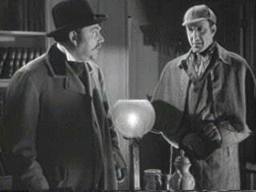
Holmes, “Have you any suggestions?”
Moriarty, “I’m going to break you Holmes. I’m going to bring off right under your nose the most incredible crime of the century, and you’ll never suspect it until it’s too late. That will be the end of you Mr. Sherlock Holmes. And when I’ve beaten and ruined you then I can retire in peace. I’d like to retire; crime no longer amuses me. I’d like to devote my remaining years to abstract science.”
Crafty direction by Alfred Werker, and a solid screenplay by Edwin Blum and William Drake. And, lovely black and white cinematography by Leon Shamroy.
http://www.videodetective.com/movie_trailer/THE_ADVENTURES_OF_SHERLOCK_HOLMES/trailer/P00003200.htm
The Big Sleep
Howard Hawks 1946
Raymond Chandler’s Philip Marlowe finds himself in a nest of vipers, as usual, in this brilliant, if a bit confusing, film noir. Howard Hawks, probably Hollywood’s best dialogue director, has
a field day, juggling juicy lingo penned by an incredible writing team that included William Faulkner, Leigh Brackett, Jules Furthman, and Hawks himself. The problem is, the story makes no sense. But, who cares, with Bogie as Marlowe, and Betty Bacall as a devious femme fatale. The now-famous jockey/horse-Bogie/Betty scene, filled with hilarious 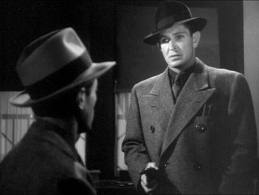 sexual innuendo, was added to the troubled production over a year later to spice things up. A solid cast, including a surprisingly sprite Dorothy Malone, makes this movie work, even if you may have trouble understanding what’s going on. Nice black and white lensing by Sidney Hickox, and a haunting, if sometimes abrupt, musical score by Max Steiner. I’ve seen this picture an embarrassing number of times, but for you, once should be enough – but see it!
sexual innuendo, was added to the troubled production over a year later to spice things up. A solid cast, including a surprisingly sprite Dorothy Malone, makes this movie work, even if you may have trouble understanding what’s going on. Nice black and white lensing by Sidney Hickox, and a haunting, if sometimes abrupt, musical score by Max Steiner. I’ve seen this picture an embarrassing number of times, but for you, once should be enough – but see it!
Best scene: Bogie and Malone in the book store.
http://www.youtube.com/watch?v=5zDqrSctpV
Chinatown
Roman Polanski 1974
1 Oscar
“C’mon Jake, it’s Chinatown”, pleads Gittes’s friend, attempting to drag him away from the horrific car scene at the very end of the film. “Chinatown” means what you think, but it’s also an old expression meaning crazy, upside-down, or meshuganah – something best left alone. This is may be the best period film ever
made, and Polanski does it without the usual cheap tricks like historical references. He does it instead, with a fabulous cast, John Alonzo’s scorched cinematography, Jerry Goldsmith’s luscious score, Anthea Sylbert’s glamorous costumes, and Robert Towne’s Oscar winning screenplay. It’s all about water – Los Angeles doesn’t have any. And the  Hollis Mulwray character is based on William Mulholland, the brilliant head of LA’s water department, who turned this parched patch of Southern California into the metropolis it was to become.
Hollis Mulwray character is based on William Mulholland, the brilliant head of LA’s water department, who turned this parched patch of Southern California into the metropolis it was to become.
Jack Nicholson, as Jake Gittes, a private eye who makes a living on matrimonial cases, is sucked into a noirish whirlpool, where  virtually nothing is as it seems. Polanski does a masterful job of slowing down Nicholson’s usually manic delivery, turning the performance into something more sensual and cunning. Faye Dunawaye is elegantly deceitful, and Polanski himself, plays a murderous knife wielding midget. But it’s John Huston’s Noah Cross that steals the show.
virtually nothing is as it seems. Polanski does a masterful job of slowing down Nicholson’s usually manic delivery, turning the performance into something more sensual and cunning. Faye Dunawaye is elegantly deceitful, and Polanski himself, plays a murderous knife wielding midget. But it’s John Huston’s Noah Cross that steals the show.
One of my all-time fave films. If anyone reading this hasn’t seen it, you’ll probably find a disc at your local library. Delicious sleuthing.
Best scene: Anything with John Huston, and “My sister – my daughter, my sister-my daughter, my sister AND my daughter.”
http://www.youtube.com/watch?v=3aifeXlnoqY
Farewell My Lovely
Dick Richards 1975
This is the third and, in my opinion, best movie made from Raymond Chandler’s 1940 novel. As I’ve previously stated, Philip Marlowe is my favorite Private Eye and, although Bogie was 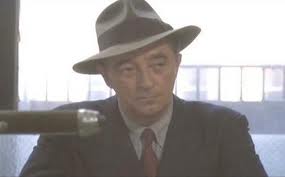 near-perfect in The Big Sleep, Robert Mitchum is even better, as a big, hulking Marlowe, who seems constantly recovering from a whack on the noggin, or the woozy effect of the knock-out drops that some swell dame slipped in his drink. Unlike Polanski’s Chinatown, director Dick Richards uses the historical reference of Joe Dimaggio’s 57 game hitting streak throughout the movie to maintain a feel for 1940 period. OK, so
near-perfect in The Big Sleep, Robert Mitchum is even better, as a big, hulking Marlowe, who seems constantly recovering from a whack on the noggin, or the woozy effect of the knock-out drops that some swell dame slipped in his drink. Unlike Polanski’s Chinatown, director Dick Richards uses the historical reference of Joe Dimaggio’s 57 game hitting streak throughout the movie to maintain a feel for 1940 period. OK, so  it’s a gimmick, but a forgivable one – it works. Come to think of it, just about everything in this movie works. Great Chandler narration like, “I’d hardly reached the corner, when a hand so big I could of sat in it, landed on my shoulder”. Besides a wonderfully effective Mitchum, Charlotte Rampling provides the heat in a cast rounded out by John Ireland and Sylvia Miles.
it’s a gimmick, but a forgivable one – it works. Come to think of it, just about everything in this movie works. Great Chandler narration like, “I’d hardly reached the corner, when a hand so big I could of sat in it, landed on my shoulder”. Besides a wonderfully effective Mitchum, Charlotte Rampling provides the heat in a cast rounded out by John Ireland and Sylvia Miles.  There’s even a quick glimpse of Sly Stallone in one of his first movie roles. Dark and sultry lensing, once again by John Alonzo, and a delicious musical score by David Shire make this recreation of 1940 Los Angeles believable. If you can find a DVD of this – pounce.
There’s even a quick glimpse of Sly Stallone in one of his first movie roles. Dark and sultry lensing, once again by John Alonzo, and a delicious musical score by David Shire make this recreation of 1940 Los Angeles believable. If you can find a DVD of this – pounce.
http://www.youtube.com/watch?v=htf7JgTmjdY
Kiss Me Deadly
Robert Aldrich 1955
No more Mr. Nice Guy – not with Mickey Spillane’s brutal, tough, take-no-prisoners Mike Hammer on the case, and in this case, the case is a box – Pandora’s Box, filled with nuclear material ready to go off. Ah, the Fifties, when every right-thinking American had  the A-Bomb on his mind, 24 hours a day. An apocalyptic murder mystery? You bet, and Mike Hammer’s the right guy to put the pieces together. A nice turn here by Ralph Meeker, as the Private Eye with an attitude problem. And the movie debuts of Cloris Leachman, and Maxine Cooper
the A-Bomb on his mind, 24 hours a day. An apocalyptic murder mystery? You bet, and Mike Hammer’s the right guy to put the pieces together. A nice turn here by Ralph Meeker, as the Private Eye with an attitude problem. And the movie debuts of Cloris Leachman, and Maxine Cooper
On a lonely country road, Hammer gives a ride to Christina  (Cloris Leachman), an attractive hitchhiker wearing nothing but a trench coat. She has escaped from a nearby mental institution. Thugs waylay them and Hammer awakens in some unknown location where he hears Christina screaming and being tortured to death. The thugs then push Hammer’s car off a cliff with Christina’s body and an unconscious Hammer inside. Hammer next awakens in a hospital with Velda (Maxine Copper) at his bedside. He decides to pursue the case, both for vengeance and because, “She (Christina) must be connected with something big”.
(Cloris Leachman), an attractive hitchhiker wearing nothing but a trench coat. She has escaped from a nearby mental institution. Thugs waylay them and Hammer awakens in some unknown location where he hears Christina screaming and being tortured to death. The thugs then push Hammer’s car off a cliff with Christina’s body and an unconscious Hammer inside. Hammer next awakens in a hospital with Velda (Maxine Copper) at his bedside. He decides to pursue the case, both for vengeance and because, “She (Christina) must be connected with something big”.
 “The great whatsit”, as Velda calls it, at the center of Hammer’s quest, is a small, mysterious valise that is hot to the touch and contains a dangerous, glowing substance. It represents, of course, the 1950s Cold War fear and nuclear paranoia about the atomic bomb that was all the rage back then.
“The great whatsit”, as Velda calls it, at the center of Hammer’s quest, is a small, mysterious valise that is hot to the touch and contains a dangerous, glowing substance. It represents, of course, the 1950s Cold War fear and nuclear paranoia about the atomic bomb that was all the rage back then.
A dark, noirish nightmare, deftly handled by director Aldrich. Murky, night time Los Angeles locations, made to shine by cinematographer Ernst Laszlo. This is a low budget ($400,000), no nonsense, first rate film noir, with a game cast, and a savvy director. A film not to miss.
http://www.youtube.com/watch?v=qCuhR_SyH8k
Laura
Otto Preminger 1944
OK, I know, I know – it’s not a private eye movie, it’s a cop caper, but it’s Laura, the one and only, and this is MY list so it’s just tough. We have to get past this. Good.
 A detective (Dana Andrews) investigating the grisly murder of a famous actress (Gene Tierney) falls in love with her painting. The more he hears about her, the deeper his spell. (I’d do the same thing if that music followed me around all the time) Everyone Andrews interviews seem to be in love with her too. Venomous gossip columnist Waldo Lydecker
A detective (Dana Andrews) investigating the grisly murder of a famous actress (Gene Tierney) falls in love with her painting. The more he hears about her, the deeper his spell. (I’d do the same thing if that music followed me around all the time) Everyone Andrews interviews seem to be in love with her too. Venomous gossip columnist Waldo Lydecker  (Clifton Webb) seems to be the late Laura’s biggest booster. Her grief stricken fiancé Shelby (Vincent Price) is beside himself. Just who would kill such a beloved creature? Just when the audience settles in to accepting lovely Laura’s demise, plot twist of plot twists, the door to her apartment opens, and in walks, you guessed it, Laura, live and lovelier than ever. Andrews, who had fallen asleep on the couch under Laura’s portrait, is awaked to find his obsession, alive and kicking, and wondering what this stranger is doing in her apartment. As Andrews adjusts to this new situation, he finds the living Laura to be everything he’d
(Clifton Webb) seems to be the late Laura’s biggest booster. Her grief stricken fiancé Shelby (Vincent Price) is beside himself. Just who would kill such a beloved creature? Just when the audience settles in to accepting lovely Laura’s demise, plot twist of plot twists, the door to her apartment opens, and in walks, you guessed it, Laura, live and lovelier than ever. Andrews, who had fallen asleep on the couch under Laura’s portrait, is awaked to find his obsession, alive and kicking, and wondering what this stranger is doing in her apartment. As Andrews adjusts to this new situation, he finds the living Laura to be everything he’d 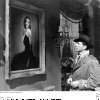 hoped. But, who was the disfigured corpse, who everyone mistook for Laura? It turns out that Lydecker’s obsession with our leading lady got the better of him. If he couldn’t have her, he’d kill her instead. But he shot the wrong woman, and she was too disfigured to identify, so everyone assumed it
hoped. But, who was the disfigured corpse, who everyone mistook for Laura? It turns out that Lydecker’s obsession with our leading lady got the better of him. If he couldn’t have her, he’d kill her instead. But he shot the wrong woman, and she was too disfigured to identify, so everyone assumed it  was Laura’s body. A living Laura is just too much for Lydecker to accept, so he tries once again to kill her. Andrews intercedes, shooting the murderous Lydecker in the knick of time. As Waldo lies dying on Laura’s carpet, and of course under the portrait, his last words are, “Goodbye. Laura. Goodbye, my love.”
was Laura’s body. A living Laura is just too much for Lydecker to accept, so he tries once again to kill her. Andrews intercedes, shooting the murderous Lydecker in the knick of time. As Waldo lies dying on Laura’s carpet, and of course under the portrait, his last words are, “Goodbye. Laura. Goodbye, my love.”
It sounds pretty silly, but it works. Tierney is simply too beautiful to believe, and a game cast does wonders with this material. But, maybe the most important element, the glue that binds this  classic together, is David Raskin’s haunting, memorable musical score – one of the real champs. I wonder what happened to the portrait?
classic together, is David Raskin’s haunting, memorable musical score – one of the real champs. I wonder what happened to the portrait?
http://www.youtube.com/watch?v=u6f8jRplej8
The Maltese Falcon
John Huston 1941
This 1941 Warner Brothers release is the third movie version of Dashiell Hammett’s novel. The first, released in 1931, starred Ricardo Cortez as Sam Spade, while the second, Satan Met a Lady, 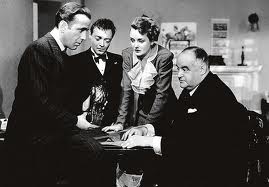 was a loose adaptation that was a bit more comedic. It was released in 1936, with Warren William, and a very young Bette Davis in the leading roles. Warner Brothers had been prevented from re-releasing the 1931 version by the Hays Office censors, because of its “lewd” content, so they went into production in 1941, on a new, cleaned up version, which is the beauty we all know and love.
was a loose adaptation that was a bit more comedic. It was released in 1936, with Warren William, and a very young Bette Davis in the leading roles. Warner Brothers had been prevented from re-releasing the 1931 version by the Hays Office censors, because of its “lewd” content, so they went into production in 1941, on a new, cleaned up version, which is the beauty we all know and love.
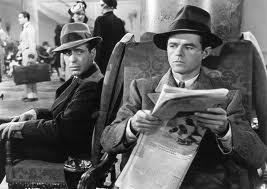 First-time director John Huston wanted Bogie to play Sam Spade, but producer Hal Wallis wanted veteran leading man George Raft, who rejected it because he didn’t want to work with a first-time director. Raft also turned down the lead in Raoul Walsh’s “High Sierra”, the film that launched Bogie’s career as a leading man.
First-time director John Huston wanted Bogie to play Sam Spade, but producer Hal Wallis wanted veteran leading man George Raft, who rejected it because he didn’t want to work with a first-time director. Raft also turned down the lead in Raoul Walsh’s “High Sierra”, the film that launched Bogie’s career as a leading man.
 An aside here – I’m reading the Hammett novel for the first time as I’m writing this. I’ve read all of Raymond Chandler, but somehow missed Hammett.
An aside here – I’m reading the Hammett novel for the first time as I’m writing this. I’ve read all of Raymond Chandler, but somehow missed Hammett.
So, is The Maltese Falcon the ultimate private eye caper? You be the judge, but if it’s not, then it’s certainly close. Warner’s had the best ensemble of character actors in Hollywood,  and most of them strut their stuff here. Beyond Bogey and Mary Astor, there’s Peter Lorre as Joel Cairo, Sidney Greenstreet as Gutman, Barton MacClane and Ward Bond as Spade’s detective buddies, and Lee Patrick as Effie, who Spade addresses as “Precious” and “Darlin”. Huston even hired his father Walter, to play the ship’s Captain.
and most of them strut their stuff here. Beyond Bogey and Mary Astor, there’s Peter Lorre as Joel Cairo, Sidney Greenstreet as Gutman, Barton MacClane and Ward Bond as Spade’s detective buddies, and Lee Patrick as Effie, who Spade addresses as “Precious” and “Darlin”. Huston even hired his father Walter, to play the ship’s Captain.
Whose got the bird, is the game played here. What exactly IS this Maltese Falcon, anyway? And why is it worth so many murders?  Astor wants it, Greenstreet wants it, Lorre wants it, and the body count is mounting. Juicy, nest of vipers stuff here, and Huston is up to the task of getting the most out of this remarkable cast. A solid, tangy screenplay, written by the first-time director, nice dark lensing by Arthur Edeson, and a warm musical score by Arthur Deutsch. A bird for all seasons.
Astor wants it, Greenstreet wants it, Lorre wants it, and the body count is mounting. Juicy, nest of vipers stuff here, and Huston is up to the task of getting the most out of this remarkable cast. A solid, tangy screenplay, written by the first-time director, nice dark lensing by Arthur Edeson, and a warm musical score by Arthur Deutsch. A bird for all seasons.
“You’re good. You’re very good”, say’s Bogie to Astor, and who among us could argue?
http://www.youtube.com/watch?v=yRSCV2qc2IY
Murder, My Sweet
Edward Dmytryk 1944
This is the second movie made from Raymond Chandler’s Farewell My Lovely novel, and has a very different feel from the 1975, and third remake, above. The powers that be at RKO thought  that changing the title to Murder, My Sweet would add some zip the film’s box office. Who knows, but the film did well.
that changing the title to Murder, My Sweet would add some zip the film’s box office. Who knows, but the film did well.
Casting crooner Dick Powell in the Marlowe role was a gamble, but he’s an effective, if different gumshoe. With a small budget to work with, and 1944’s censorship problems to overcome, Dmytryk does an admirable  job creating a dark, violent world for Marlowe and his cronies to inhabit. Nice turns by Claire Trevor, Anne Shirley, and Otto Kruger. And, solid black and white camerawork by Harry Wild, plus a low-key musical score by Roy Webb rounds out the production. Powell is surprising here, and worth a look. Like Alec Guinness as George Smiley, when I read Chandler, I hear Mitchum’s voice, but Powell gives us an alternative.
job creating a dark, violent world for Marlowe and his cronies to inhabit. Nice turns by Claire Trevor, Anne Shirley, and Otto Kruger. And, solid black and white camerawork by Harry Wild, plus a low-key musical score by Roy Webb rounds out the production. Powell is surprising here, and worth a look. Like Alec Guinness as George Smiley, when I read Chandler, I hear Mitchum’s voice, but Powell gives us an alternative.
http://www.youtube.com/watch?v=hIVAF6AVaSw
Murder on the Orient Express
Sidney Lumet 1974
Agatha Chistie had been quite displeased with some film adaptations of her works made in the 1960s, and accordingly, was  unwilling to sell any more film rights. When Nat Cohen, chairman of EMI Films, and producer John Brabourne attempted to get her approval for this film, they felt it necessary to have Lord Mountbatten of Burma (of the British Royal Family and also Brabourne’s father-in-law) help them broach the subject.
unwilling to sell any more film rights. When Nat Cohen, chairman of EMI Films, and producer John Brabourne attempted to get her approval for this film, they felt it necessary to have Lord Mountbatten of Burma (of the British Royal Family and also Brabourne’s father-in-law) help them broach the subject.
In the end, according to Christie’s husband Max Mallowan, “Agatha herself has always been allergic to the adaptation of her  books by the cinema, but was persuaded to give a rather grudging appreciation to this one.” Christie’s biographer, Gwen Robyns, quoted her as saying, “It was well made except for one mistake. It was Albert Finney, as my detective Hercule Poirot. I wrote that he had the finest moustache in England — and he didn’t in the film. I thought that a pity — why shouldn’t he?”
books by the cinema, but was persuaded to give a rather grudging appreciation to this one.” Christie’s biographer, Gwen Robyns, quoted her as saying, “It was well made except for one mistake. It was Albert Finney, as my detective Hercule Poirot. I wrote that he had the finest moustache in England — and he didn’t in the film. I thought that a pity — why shouldn’t he?”
Hey, Finney’s waxed lip-rug worked for me, but so did everything  else in this dazzling film. I’m not the biggest fan of star vehicles, but Sidney Lumet somehow coaxed, cajoled, persuaded, and probably black-mailed this extraordinary ensemble of show business luminaries into one remarkable performance after another. Finney is a fastidious, almost effeminate Poirot, surrounded by a passenger list that includes (I’m going to name them all because it’s just such an amazing group) Lauren Bacall, Sean Connery, Ingrid Bergman, Michael York, Vanessa Redgrave,
else in this dazzling film. I’m not the biggest fan of star vehicles, but Sidney Lumet somehow coaxed, cajoled, persuaded, and probably black-mailed this extraordinary ensemble of show business luminaries into one remarkable performance after another. Finney is a fastidious, almost effeminate Poirot, surrounded by a passenger list that includes (I’m going to name them all because it’s just such an amazing group) Lauren Bacall, Sean Connery, Ingrid Bergman, Michael York, Vanessa Redgrave, 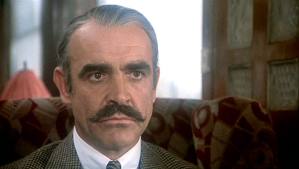 Jacqueline Bisset, Richard Widmark, John Gielgud, Anthony Perkins, Martin Balsam, Rachel Roberts, Wendy Hiller, Denis Quilley, Colin Blakely, Jean-Pierre Cassel, and George Coulouris. And, their performances are all uniquely effective, and totally entertaining.
Jacqueline Bisset, Richard Widmark, John Gielgud, Anthony Perkins, Martin Balsam, Rachel Roberts, Wendy Hiller, Denis Quilley, Colin Blakely, Jean-Pierre Cassel, and George Coulouris. And, their performances are all uniquely effective, and totally entertaining.
A complex Agatha Christie mystery, in the hands of a neurotic,  self-involved detective, on the world’s greatest train, with a trainload of odd characters as suspects. Top notch lensing here by the masterful Geoffrey Unsworth, a lovely, waltzy score by Richard Rodney Bennett, and Lumet’s crafty direction make this memorable.
self-involved detective, on the world’s greatest train, with a trainload of odd characters as suspects. Top notch lensing here by the masterful Geoffrey Unsworth, a lovely, waltzy score by Richard Rodney Bennett, and Lumet’s crafty direction make this memorable.
Best lines:
A throaty Finney, “Touch notheeeeeeng”
John Gielgud as a British valet, “It all started in a fracas in the mess, over a desert called “Spotted Dick”
Igrid Bergman as a Swedish missionary to Africa, “I vont to, um, help little brown babies, who, um, are less fortunate than, um, myself”
http://www.youtube.com/watch?v=JTYA01glGqo
The Thin Man
W. S. Van Dyke 1934
Dashiell Hammett’s crafty couple Nick and Nora Charles are on the case here, in the original of, what would become, a series of  detective capers. They’ve even got a snoopy, clue-fetching dog, Asta – played by a wire haired fox terrier named Skippy. Nick (William Powell), a retired detective, and his wife Nora (Myrna Loy) are attempting to settle in to retirement when the disappearance of a friend pulls him back into professional snooping. Nick decides he’ll solve the case, much to the amusement of his socialite wife.
detective capers. They’ve even got a snoopy, clue-fetching dog, Asta – played by a wire haired fox terrier named Skippy. Nick (William Powell), a retired detective, and his wife Nora (Myrna Loy) are attempting to settle in to retirement when the disappearance of a friend pulls him back into professional snooping. Nick decides he’ll solve the case, much to the amusement of his socialite wife.  The dead bodies, and empty martini glasses pile up, as an ever-tipsy Nick and Nora, endlessly clever banter at the ready, roll up their sleeves, along with their pup, and do some slippery sleuthing.
The dead bodies, and empty martini glasses pile up, as an ever-tipsy Nick and Nora, endlessly clever banter at the ready, roll up their sleeves, along with their pup, and do some slippery sleuthing.
All of the suspects are invited to a hilarious dinner party, where Nick and Nora, in a series of brilliant, if tipsy, deductions, solve the mystery. Clever  dialogue, written by Albert Hackett and Frances Goodrich, and deftly delivered by two pros, drives this unique, comedic mystery. Sparkling black and white lensing by James Wong Howe, and strong ensemble work by Metro’s talent pool make this a movie not to miss. Funny doings.
dialogue, written by Albert Hackett and Frances Goodrich, and deftly delivered by two pros, drives this unique, comedic mystery. Sparkling black and white lensing by James Wong Howe, and strong ensemble work by Metro’s talent pool make this a movie not to miss. Funny doings.
http://www.youtube.com/watch?v=nSNJ-8ouQEM
*
© 2011 Shaun Costello
SALVATORE’S MAID
SALVATORE’S MAID
She had breasts the size of basketballs.
By Shaun Costello
This story is excerpted from my childhood memoir:
THE LAST TIME I SAW JESUS
Surviving God and Elvis in the time of ‘Duck and Cover’
My new friend Jimmy’s family had recently moved to the Gardens from Brooklyn. His father was a famous theatrical photographer who took pictures of movie stars. They lived in an enormous Tudor house on Greenway South, one on the nicest streets in the Gardens where I began to spend a great deal of time. One day Jimmy asked me if I had ever touched a breast. Other than the pictures I saw of Eddie Mann’s mom, I had never even seen one. He told me that he had touched a breast, and if I was interested, he could arrange for me to touch one too. Jimmy had a neighbor named Salvatore, who lived just down the street, and Salvatore’s family had a black maid named Jessie who, for fifty cents would let you fondle her breasts for five minutes. “And they’re really big too”, Jimmy added. This was a shocking revelation. Breasts. Actual breasts. You could touch them and even kiss them, and all for fifty cents. I was nervous but game, and Jimmy made the arrangements.
“What do you do with them?”, I asked. “Anything you want”, said Jimmy. “But why do I want to touch them?” I’m nervous now. “Because they’re beasts, stupid”.
Salvatore lived in a big brick house just down the street from Jimmy. Jessie, the maid lived in a room over the garage, and Salvatore, with Dolphy Maggiore in tow, met us outside. We hid our bikes in the bushes behind the house. Salvatore was very  concerned that everyone had their money in their hands because Jessie could get ornery and make a fuss. As Salvatore opened the outside door to the stairway that led to Jessie’s room there was a horrible smell, something I had never smelled before, and it became worse as we climbed the stairs. A smell of something burning. A pungent, rancid smell. Salvatore knocked on the door. “Who?”, came from the other side. “It’s me”,
concerned that everyone had their money in their hands because Jessie could get ornery and make a fuss. As Salvatore opened the outside door to the stairway that led to Jessie’s room there was a horrible smell, something I had never smelled before, and it became worse as we climbed the stairs. A smell of something burning. A pungent, rancid smell. Salvatore knocked on the door. “Who?”, came from the other side. “It’s me”, 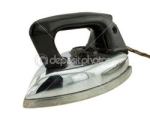 said Salvatore. “Well c’mon honey, I ain’t got all day”. The door opened, and inside, sitting in front of a large mirror, applying hot irons to straighten her hair, was the biggest, fattest black woman I had ever seen. She spoke to us through the mirror. “You chilluns got my jingle?” she asked. Salvatore made a gesture that suggested giving her the money, so we did. At this point she let the robe she was wearing slip to her waste revealing huge brown breasts the size of basketballs, to the amazement and delight of the white chilluns. “C’mon now, don’t be shy. You got five minutes. Love’m up. C’mon now, love’m up”. With hesitation, fearing the unknown but mesmerized by the possibilities, the little fingers of the white chilluns
said Salvatore. “Well c’mon honey, I ain’t got all day”. The door opened, and inside, sitting in front of a large mirror, applying hot irons to straighten her hair, was the biggest, fattest black woman I had ever seen. She spoke to us through the mirror. “You chilluns got my jingle?” she asked. Salvatore made a gesture that suggested giving her the money, so we did. At this point she let the robe she was wearing slip to her waste revealing huge brown breasts the size of basketballs, to the amazement and delight of the white chilluns. “C’mon now, don’t be shy. You got five minutes. Love’m up. C’mon now, love’m up”. With hesitation, fearing the unknown but mesmerized by the possibilities, the little fingers of the white chilluns
reached for the huge, soft, brown basketballs, while Jessie applied the hot irons to her singed hair, creating an unbearable smell, and Symphony Sid’s radio theme song wafted through the smoke, and all I could think of was how I could tell this in confession on Saturday.
*
© 2011 Shaun Costello
IN SHERMAN’S GARAGE
IN SHERMAN’S GARAGE
She Looked So Peaceful
By Shaun Costello
Excerpted from the manuscript of my childhood memoir:
THE LAST TIME I SAW JESUS
Surviving God and Elvis in the time of ‘Duck and Cover’
The Kew Forest School was located right on the border between the Forest Hills Gardens, and Kew Gardens, the next community to the East. Their student body was made up of a pretty even smattering of Protestants and  Jews, with a few recovering Catholics thrown in for good measure. It was a small, secular, private school, attended by students from all over the borough of Queens. My friend Jimmy went there, and the Bullock twins, the Baxter brothers, Jeff McGann, Frank Sperandeo, and several other kids I knew from the Gardens. It was the kind of institution that was completely outside my experience. There was no hitting, no statues with internal organs showing, no threats, no Sousa marches, no praying, no music room/punishment chamber, and no promise of the eternal agony of roasting in the fires of hell for the egregious crime of talking on line. I don’t think they even had a line. A very mysterious place.
Jews, with a few recovering Catholics thrown in for good measure. It was a small, secular, private school, attended by students from all over the borough of Queens. My friend Jimmy went there, and the Bullock twins, the Baxter brothers, Jeff McGann, Frank Sperandeo, and several other kids I knew from the Gardens. It was the kind of institution that was completely outside my experience. There was no hitting, no statues with internal organs showing, no threats, no Sousa marches, no praying, no music room/punishment chamber, and no promise of the eternal agony of roasting in the fires of hell for the egregious crime of talking on line. I don’t think they even had a line. A very mysterious place.
 Knowing their route home from school, I would sometimes intercept Stuart and Stephen Bullock, and the three of us would cruise the Gardens on our bikes for a while before winding up at their house for a snack. I liked the Bullocks. They were my size, had the same coloring, were totally unchallenging, and were even worse at sports than I was. Sometimes it was comforting to wallow in the company of compatible mediocrity. My friend Jimmy, on the other hand, who was a constant mental challenge, was good at everything. He was the best natural athlete I had ever seen, the best tennis player his age in the borough. The first time he ever picked up a basketball in his life I saw him make six shots in a row from the foul line. Six shots. It took me a year of daily practice before I
Knowing their route home from school, I would sometimes intercept Stuart and Stephen Bullock, and the three of us would cruise the Gardens on our bikes for a while before winding up at their house for a snack. I liked the Bullocks. They were my size, had the same coloring, were totally unchallenging, and were even worse at sports than I was. Sometimes it was comforting to wallow in the company of compatible mediocrity. My friend Jimmy, on the other hand, who was a constant mental challenge, was good at everything. He was the best natural athlete I had ever seen, the best tennis player his age in the borough. The first time he ever picked up a basketball in his life I saw him make six shots in a row from the foul line. Six shots. It took me a year of daily practice before I  even came close to that. He was just better than I was at everything, and probably always would be. He was my best friend, but sometimes I needed a short respite from constantly coming in second, and the Bullock twins were just what the Doctor ordered. The boys were funny, their parents were welcoming and friendly, and the whole after school experience at their house was pretty positive. When it was time for me to return home, we said our good-byes, and made plans for a repeat performance the next day.
even came close to that. He was just better than I was at everything, and probably always would be. He was my best friend, but sometimes I needed a short respite from constantly coming in second, and the Bullock twins were just what the Doctor ordered. The boys were funny, their parents were welcoming and friendly, and the whole after school experience at their house was pretty positive. When it was time for me to return home, we said our good-byes, and made plans for a repeat performance the next day.
It was about a five-minute bike ride from their house to mine, and riding a bicycle around the Gardens was one of the best things about living there. There was very little traffic, and after a while you got to know most of the residents, so that people would wave to you as you cruised by. After  collecting waves from Mrs. Watson, and Doctor Kauer, I passed by Sherman Becker’s house, and there was old Sherm, sitting on a bench next to his garage. The word on Sherman Becker was that he was some kind of genius. He went to a special school in Manhattan for kids with extremely high IQ’s and, although a bit strange, he was a nice enough kid to be around. Sometimes in the middle of a sentence Sherman would drift off to some place far away, and
collecting waves from Mrs. Watson, and Doctor Kauer, I passed by Sherman Becker’s house, and there was old Sherm, sitting on a bench next to his garage. The word on Sherman Becker was that he was some kind of genius. He went to a special school in Manhattan for kids with extremely high IQ’s and, although a bit strange, he was a nice enough kid to be around. Sometimes in the middle of a sentence Sherman would drift off to some place far away, and  just stare at nothing that was visible to anyone else. I never saw it, but kids told me than Sherman had seizures, where his whole body would shake, and he would fall on the floor and try to swallow his tongue. He had an illness called Epilepsy, and had to take medication that sometimes made him moody. “Hey Sherm”, I yelled, as I cruised by, but he didn’t seem to notice me, and I continued on down the street. After a few blocks I stopped. Something was wrong. Sherman looked like he was doing one of his, “staring into oblivion” routines, and if his parents weren’t home maybe it was dangerous, so I turned abound and headed back to his house.
just stare at nothing that was visible to anyone else. I never saw it, but kids told me than Sherman had seizures, where his whole body would shake, and he would fall on the floor and try to swallow his tongue. He had an illness called Epilepsy, and had to take medication that sometimes made him moody. “Hey Sherm”, I yelled, as I cruised by, but he didn’t seem to notice me, and I continued on down the street. After a few blocks I stopped. Something was wrong. Sherman looked like he was doing one of his, “staring into oblivion” routines, and if his parents weren’t home maybe it was dangerous, so I turned abound and headed back to his house.
He was sitting on the bench next to his garage, and just staring into space. I had seen him do this many times and, sooner or later, he would just snap out of it. I tried talking with him, but got no response. Sherman was somewhere  far away, and I’m sure he had no idea that I was even there. It was at this point that I became aware of a noise. A humming, mechanical sound, like a car motor, but very quiet, like it was far away. But it wasn’t far away. It was in Sherm’s garage, and with the doors closed you could hardly hear it. The Sisters had shown us safety films at school about the dangers of running a car
far away, and I’m sure he had no idea that I was even there. It was at this point that I became aware of a noise. A humming, mechanical sound, like a car motor, but very quiet, like it was far away. But it wasn’t far away. It was in Sherm’s garage, and with the doors closed you could hardly hear it. The Sisters had shown us safety films at school about the dangers of running a car  inside a garage. There was some kind of gas that put you to sleep, and you never woke up. So the logical thing seemed to be for me to open the garage doors and somehow turn the car off. I opened both of the large front doors, and the smoke inside was a silvery color, and had a gasoline smell. There was a small back door to the building so I ran around and opened it, thinking that the breeze would blow the poisonous fumes from the garage.
inside a garage. There was some kind of gas that put you to sleep, and you never woke up. So the logical thing seemed to be for me to open the garage doors and somehow turn the car off. I opened both of the large front doors, and the smoke inside was a silvery color, and had a gasoline smell. There was a small back door to the building so I ran around and opened it, thinking that the breeze would blow the poisonous fumes from the garage.
I stood there, waiting for the fumes to clear so that I could somehow shut the car off, when I saw it. There was something or someone in the car, behind the steering wheel. I froze. As the breeze blew the silver smoke past me I could see that it was a person. All I knew was that I had to turn the car off, so I covered my nose and mouth and ran for the front door on the driver’s side. I opened the door to reach for the keys when I came face to face with Mrs. Becker. I gasped and flew backwards, crashing into the garage wall. My lungs were expanding and contracting with such force that I could hear my breath over the din of the motor, and I could barely see through the tears. I was violently crying, not from sadness, but from shock and fear. I had to turn that car off, no matter what, so I opened the door again and reached across Mrs. Becker’s lap and fumbled with key, which was on the right of the steering column. Doing this bought my face inches from hers, and my whole body was trembling so violently that I couldn’t seem to turn the key. But then I did, and the motor stopped, and I was still only inches from Mrs. Becker, and I could hear myself gasping for air. I wanted to say something to her. Maybe she was only asleep. She looked so peaceful. But my mouth wouldn’t move. The words wouldn’t come. Maybe she would open her eyes, and stretch her arms the way people do when they wake up, and look down at me and invite me to dinner. But she didn’t. She didn’t move. I realized that Sherm was still outside so I backed slowly out of the garage, never taking my eyes off Mrs. Becker.
Sherm hadn’t moved a muscle. His mind was occupying another world altogether, either because be was steeped in the denial of this horrible event, or because that’s just what his mind sometimes did. There was no 911 back in the fifties. Emergencies were reported to the telephone operator, who then forwarded the information to the appropriate authorities, so I dialed “O”. When she answered I said that my name was Sherman Becker, told her the address, and that there had been a terrible accident, and I hung up. Outside I tried to communicate with Sherm, but had no success. He had no idea that I was there. I had done what I could do. I had tuned off the motor, and reported the tragedy, and the best thing for me to do was to get out of there before the police came. No one would ever know that I had been there. They would simply assume that Sherman turned off the car motor, called the operator, and then flipped out, which was pretty understandable under the circumstances. I just didn’t want to be involved in this.
I raced toward home as fast my legs could peddle, but after a while I came to a stop, dropped my bike, sat down on the curb and started sobbing, completely overwhelmed by the events of the past few minutes. Or was it longer? I had lost track of time. My lungs seemed near exploding, my breath gushing in and out, wheezing like an asthmatic gasping for air. I had seen dead people before on Wayne Baxter’s cadaver tour, but this was different. I knew Mrs. Becker. She had always been nice to me, and now she was dead. She wanted to be dead so she closed her garage doors, slid behind the wheel, turned on the motor, fell asleep, and then died, just like in the safety film we saw in school. But she didn’t look dead. Not like the translucent cadavers at the Fox Funeral Home. She looked like she was asleep. She looked so peaceful.
*
© 2009 Shaun Costello
THE EXORCIST
THE EXORCIST
Drowning Satan with Holy Water-boarding
By Shaun Costello
This story is excerpted from the manuscript of my childhood memoir;
“The Last Time I Saw Jesus”
Surviving God and Elvis in the time of ‘Duck and Cover’
Children, like sharks with blood in the water, or wild dogs who smell fear, can spot weakness a mile away, and will bide their time until the moment is right  to pounce. Sister Lenore showed up one day at Our Lady Queen of Martyrs, and became our teacher. She replaced Sister Saint Gerald, who was ill and had to be sent to convalesce wherever nuns went to do that sort of thing. Nuns never talked about themselves so, other than being our teachers, having incredibly clean fingernails, wearing rimless spectacles, enjoying hitting children with inanimate objects, and seldom smiling, we knew little about them. We knew that their order, The Sisters of the Immaculate Conception, came from Scranton Pennsylvania, but that’s all. I’m not even sure how we knew that, but somehow we did. So when Sister Lenore showed up that morning, the occasion was ripe for supposition.
to pounce. Sister Lenore showed up one day at Our Lady Queen of Martyrs, and became our teacher. She replaced Sister Saint Gerald, who was ill and had to be sent to convalesce wherever nuns went to do that sort of thing. Nuns never talked about themselves so, other than being our teachers, having incredibly clean fingernails, wearing rimless spectacles, enjoying hitting children with inanimate objects, and seldom smiling, we knew little about them. We knew that their order, The Sisters of the Immaculate Conception, came from Scranton Pennsylvania, but that’s all. I’m not even sure how we knew that, but somehow we did. So when Sister Lenore showed up that morning, the occasion was ripe for supposition.
Maybe she had been a missionary in darkest Africa, and was laid low with jungle fever, to be sent back to the States as a teacher. Maybe she toiled for many  years in a convent dedicated to the glory of cleaning the toilets of the poor, and as a reward for always producing the cleanest bowl she was sent to
years in a convent dedicated to the glory of cleaning the toilets of the poor, and as a reward for always producing the cleanest bowl she was sent to  our wonderful Parish. Maybe she worked as the personal assistant to the Pope himself, right there in Rome, but was caught with her fingers in the poor box, and was sent to teach at our school as punishment for her sins. We’d never really know for sure, but it was fun to pretend.
our wonderful Parish. Maybe she worked as the personal assistant to the Pope himself, right there in Rome, but was caught with her fingers in the poor box, and was sent to teach at our school as punishment for her sins. We’d never really know for sure, but it was fun to pretend.
Anyway, here she was, so we’d just have to make the best of it. She seemed nice enough. Certainly nicer than that cranky Sister Saint Gerald, who was  always coughing into a handkerchief, and swatting kids on the hands with rulers. She seemed friendly, eager to please, even helpful, but something was wrong. It was hard to put your finger on just what, but something was wrong with Sister Lenore.
always coughing into a handkerchief, and swatting kids on the hands with rulers. She seemed friendly, eager to please, even helpful, but something was wrong. It was hard to put your finger on just what, but something was wrong with Sister Lenore.
The exorcisms began when, one morning, we found  a Holy Water Fountain just inside the door to our classroom. Sister instructed us to dip our fingers in the sacred waters and cross ourselves before entering the classroom, a common practice when entering or leaving a church. She told us that little children have tiny demons inside them that cause bad behavior, and demons just could not abide the sacred, soul-cleansing waters. This level of demon control lasted for only a few weeks, before she began sprinkling Holy Water directly from a bottle onto the heads of the unruly little perps, whose behavioral irregularities were obviously a direct result of Satanic possession.
a Holy Water Fountain just inside the door to our classroom. Sister instructed us to dip our fingers in the sacred waters and cross ourselves before entering the classroom, a common practice when entering or leaving a church. She told us that little children have tiny demons inside them that cause bad behavior, and demons just could not abide the sacred, soul-cleansing waters. This level of demon control lasted for only a few weeks, before she began sprinkling Holy Water directly from a bottle onto the heads of the unruly little perps, whose behavioral irregularities were obviously a direct result of Satanic possession.
During playground conversations over the next few weeks among the core group of class troublemakers, of which I was certainly a part, we came to the conclusion that the woman was a fruitcake, and if pushed far enough, she was bound to crack. Since we knew that she was the only nun in the school who sprinkled water on misbehaving kids rather than swatting them with yardsticks, we figured it was safe to go on the attack.
So it began. Spitball wars, paper plane dog fights, strange messages from Satan that somehow wound  up on the blackboard, demonic drawings left in her desk drawers, and the odd behavior of Jim Freeny, the class arch-criminal, whose whole body sometimes shook as a direct result of Satanic possession. For our new teacher, this was the beginning of the end. Sister would walk up and down the aisles spraying her students with Holy Water
up on the blackboard, demonic drawings left in her desk drawers, and the odd behavior of Jim Freeny, the class arch-criminal, whose whole body sometimes shook as a direct result of Satanic possession. For our new teacher, this was the beginning of the end. Sister would walk up and down the aisles spraying her students with Holy Water  chanting, “You’re possessed, possessed by devils, possessed by Satan, possessed, possessed. It started as a muffled giggle, but Jim Freeny started laughing and couldn’t seem to stop. The more he laughed, the wetter he became, as sister had singled him out as Satan’s host. She kept dousing him with the sacred fluids, and the wetter he got the louder he laughed, and the more she kept screaming at the devil to leave this child, until finally, frustrated to a point of holy rage, she cold-cocked Freeny with the Holy Water bottle.
chanting, “You’re possessed, possessed by devils, possessed by Satan, possessed, possessed. It started as a muffled giggle, but Jim Freeny started laughing and couldn’t seem to stop. The more he laughed, the wetter he became, as sister had singled him out as Satan’s host. She kept dousing him with the sacred fluids, and the wetter he got the louder he laughed, and the more she kept screaming at the devil to leave this child, until finally, frustrated to a point of holy rage, she cold-cocked Freeny with the Holy Water bottle.
So, Sister Lenore stood above Jim Freeny’s unconscious form, now lying in the aisle next to his desk, as fifty-nine little mouths silently hung open, stunned at what they had just witnessed, and wondering what would happen  next, and she began to scream. She screamed out the classroom door, and screamed down the stairwell, and screamed all the way back to the convent, intensely watched by fifty nine sets of little eyes pressed against the classroom windows. Freeny was taken to the hospital with a concussion, and never admitted whether he was really unconscious, or just pretending, a subject of discussion for years afterward. The next day someone saw Sister Lenore, suitcase in hand, being helped into a sedan with Pennsylvania license plates. She was never seen again. Maybe she should have stayed in Africa. Accidentally wondering into a pride of lions had to be safer than teaching fourth grade at Our Lady Queen of Martyrs.
next, and she began to scream. She screamed out the classroom door, and screamed down the stairwell, and screamed all the way back to the convent, intensely watched by fifty nine sets of little eyes pressed against the classroom windows. Freeny was taken to the hospital with a concussion, and never admitted whether he was really unconscious, or just pretending, a subject of discussion for years afterward. The next day someone saw Sister Lenore, suitcase in hand, being helped into a sedan with Pennsylvania license plates. She was never seen again. Maybe she should have stayed in Africa. Accidentally wondering into a pride of lions had to be safer than teaching fourth grade at Our Lady Queen of Martyrs.
*
© 2009 Shaun Costello
WALKING IN A WICCA WONDERLAND
WALKING IN A WICCA WONDERLAND
Original music by Felix Bernard
New lyrics by Shaun Costello.
Just sing these lyrics to the melody of that old Christmas Classic:
WALKING IN A WINTER WONDERLAND
Casting spells must be thrilling,
to ensure off-shore drilling.
I can’t wait to see,
that dear GOP
Walking in a Wicca Wonderland
In the meadow we will build a pyre,
Witchy ones will watch us with a frown.
I’ll say grab those logs and pile them higher,
‘cause which hunts are the biggest game in town.
Turning Newts into toadstools,
While Gulf oil fills our tide pools.
She’ll just grab her broom,
while singin’ that tune,
Walking in a Wicca Wonderland
While in Congress Dems are really freaking,
wondering how long we’ll be in town.
Sarah Palin’s hope chest she’s been tweaking,
with Bachmann and O’Donnell still around.
Will that coven conspire,
making healthcare costs higher?
And howl at the moon,
while humming that tune,
Walking in a Wicca Wonderland.
Walking in a Wicca Wonderland,
Oh Yeah
Walking in a Wicca Wonderland,
Oh My
Walking in a Wicca Wonderland.
That’s all.
*
© 2011 Shaun Costello
RED SKY AT MORNING
RED SKY AT MORNING
By 1982 my downward spiral was well under way,
not that I wasn’t enjoying myself.
By Shaun Costello
The sun was an hour from rising, and the sky was a fiery red when we drove the trailer over the Mid Hudson Bridge on our way to Rhinebeck. Skies like this always reminded me of the old sea shanty that began:
“Red sky at morning, sailor’s warning.
Red sky at night, sailor’s delight.”
There were three of us riding in the cab of my truck; myself, Harriett, and Becky, a local high-schooler who was working as our groom for the day. The lights in the barn had burned late the  night before. There were coats to be washed and brushed, manes and tails to be pulled and braided, hoofs to be polished, tack to be soaped and scrubbed, and everything, other than our two now-immaculate horses, packed into the trailer for the next day’s competition. Then home to try to get some sleep, which never happened because I was too terrified of my dressage test. If only I could get through the dressage test, the next two phases of the competition would be a breeze. I could always get horses over fences. But the dressage test.
night before. There were coats to be washed and brushed, manes and tails to be pulled and braided, hoofs to be polished, tack to be soaped and scrubbed, and everything, other than our two now-immaculate horses, packed into the trailer for the next day’s competition. Then home to try to get some sleep, which never happened because I was too terrified of my dressage test. If only I could get through the dressage test, the next two phases of the competition would be a breeze. I could always get horses over fences. But the dressage test.
I would lie awake staring at the ceiling, going through the test over and over. Enter at “A” at a working trot. Keep it straight, keep it straight. Collect and halt at “X”. Settle. Be still. Salute the judge. Be still. Wait for the nod. Pray to God that somebody’s truck doesn’t backfire. Exhale. Proceed to “C” at a working walk. What a nightmare. If I could just get through the dressage test.
In the back of the trailer were two one-thousand-pound animals;  primped, polished, and ready to show their stuff. In the front was a changing compartment that contained our freshly cleaned tack, our riding clothes, our boots and helmets, and the various tools and horsey gadgets that would see us through the event. In my tack trunk hung my custom tailored riding jacket, and in the inside pocket of that jacket were four tiny glass one-gram bottles of Peruvian flake. It would be a four-gram day.
primped, polished, and ready to show their stuff. In the front was a changing compartment that contained our freshly cleaned tack, our riding clothes, our boots and helmets, and the various tools and horsey gadgets that would see us through the event. In my tack trunk hung my custom tailored riding jacket, and in the inside pocket of that jacket were four tiny glass one-gram bottles of Peruvian flake. It would be a four-gram day.
My dressage test was a blank. I entered the ring, I left the ring, and I couldn’t remember a thing. Probably better that way. When I looked at the scores that were posted outside the judge’s tent I was 58th, out of 65 riders. There were actually seven riders who were worse than I was. Not bad. Maybe the coke helped. I had already gone through the first gram. And, unknown to Harriett, my tiny coke spoon was secretly  finding its way to Becky’s willing little nostrils throughout the morning. There’s a sexual dynamic to the shared cocaine experience. You do a line, and first there’s the exhilaration – the heightened awareness followed, only moments later, by the glow of sensuality, and sense of well being. Then she does a line, and you know what she’s experiencing, and you want her to know that you know, and you want to kiss her, and hold her, and touch her everywhere. You want to join her experience. Of course, this could be embarrassing if she’s only sixteen, and the two of you are standing in the middle of three hundred other people, so you keep your hands to yourself. And as the day progressed, and we kept up the coke consumption, the heightened sexuality between us became more intense. I worried that Harriett would notice the amount of time I was spending with Becky in the dressing compartment of the trailer, but she was preoccupied with her own riding and didn’t seem to pay attention.
finding its way to Becky’s willing little nostrils throughout the morning. There’s a sexual dynamic to the shared cocaine experience. You do a line, and first there’s the exhilaration – the heightened awareness followed, only moments later, by the glow of sensuality, and sense of well being. Then she does a line, and you know what she’s experiencing, and you want her to know that you know, and you want to kiss her, and hold her, and touch her everywhere. You want to join her experience. Of course, this could be embarrassing if she’s only sixteen, and the two of you are standing in the middle of three hundred other people, so you keep your hands to yourself. And as the day progressed, and we kept up the coke consumption, the heightened sexuality between us became more intense. I worried that Harriett would notice the amount of time I was spending with Becky in the dressing compartment of the trailer, but she was preoccupied with her own riding and didn’t seem to pay attention.
I did well in the cross-country phase, and was now 20th, out of the 65 competitors. I was also now half way through my third gram, with the help of my loyal groom, who was assisting me through the obligatory wardrobe changes that happen before each phase in the competition, her young hands brushing dangerously close to places where they should never have been. I was second in stadium Jumping, the third and last phase of the competition, and wound up sixth overall, getting a green ribbon for my efforts.
It was after nine by the time we dropped Harriett off at the house, and drove around to the barn to unload the trailer and feed the horses. Becky insisted that I drop her at the beginning of the long driveway to her parent’s house. There was an awkward moment, the two of us standing beside my truck, when I handed her twenty dollars, which was her groom’s fee for the day. I told her it should
be more and she said, “Are you kidding? I’d do it for nothing. I’d do anything for you. Have you got another hit?” And suddenly it happened. It had to. The kissing, and groping, and tearing of clothes, and the coldness of the metal bed of the pickup truck against my skin, and she was so willing to please me, and she was so young and delicious, and I’m not sure how long it lasted, and then there was nothing but the loud breathing, and then the cold. I don’t think we said another word to each other. There was nothing really to say. I dropped her off further up the driveway, closer to her parent’s house, and then drove home.
Harriett was still up, and she was bristling. When I asked her if she wanted me to fix a late supper she refused to talk to me. I guess my flirtation with Becky must have been obvious, and it had happened within full view of most of our friends. Harriett was livid. So I had a glass of port, and went upstairs to finally get some sleep. All in all, Harriett’s objections not withstanding, it had been a good day. A green ribbon day. A four gram day. That’s the way I  saw it. That’s the way my mind worked. It was the logic of the coke spoon. Harriett’s taking exception to my behavior was simply an annoyance. A small bump in my road to self-satisfaction. A minor glitch. And what was she objecting to? Just, my ingesting enough cocaine hydrochloride over the last fourteen hours to give a normal person a seizure. And sharing a good deal of it with an underage girl, with whom I had a felonious sexual encounter in the back of a pick-up truck. And, in my coked-out haze, I thought it had been a good day. Just how many more ‘good days’ like this one could I survive? How many could the people around me survive? The collateral damage was mounting.
saw it. That’s the way my mind worked. It was the logic of the coke spoon. Harriett’s taking exception to my behavior was simply an annoyance. A small bump in my road to self-satisfaction. A minor glitch. And what was she objecting to? Just, my ingesting enough cocaine hydrochloride over the last fourteen hours to give a normal person a seizure. And sharing a good deal of it with an underage girl, with whom I had a felonious sexual encounter in the back of a pick-up truck. And, in my coked-out haze, I thought it had been a good day. Just how many more ‘good days’ like this one could I survive? How many could the people around me survive? The collateral damage was mounting.
My journey towards oblivion was gaining momentum now. I was riding a runaway train. I was out of control, and it didn’t scare me a bit. ‘Out of control’ was delicious. ‘Out of control’ was a safe haven from responsibility. ‘Out of control’ was my excuse-of-choice for all my sins. ‘Out of control’ was my last alias. It was the outfit I wore to the costume party that my life had become. Maybe ‘out of control’ had been my intended destination all along. Since, taking advantage of the youth-fare, and boarding the train as a
twelve-year-old, while negotiating with God about masturbation. Since hiding behind my first pseudonym. Since becoming comfortable with duplicity. Since telling my first lie. I had lied to Jane, and Jane had lied to her parents, and her parents had lied to themselves. All aboard. Next stop self-destruction.
I was spending more than I was earning, and funds were becoming dangerously low. My ability to generate income through producing pornography, something I had always taken for granted, was now seriously impaired by the cognitive congestion in my coked-out brain. Spending money was seductive. Another ounce. A new thoroughbred. “How much? Sure, I’ll take it. No, give me two. Hey everybody, I’ve got more
 coke, have some. Want some quaaludes? Sure, I’ve got plenty. And have some more coke. Hey, lets go to Jamaica for the weekend, my treat. Let’s call a limo. I can charge it. But please like me, OK? I just want everyone to like me. Please”. I needed compensation for my own self-loathing.
coke, have some. Want some quaaludes? Sure, I’ve got plenty. And have some more coke. Hey, lets go to Jamaica for the weekend, my treat. Let’s call a limo. I can charge it. But please like me, OK? I just want everyone to like me. Please”. I needed compensation for my own self-loathing.
Harriett was fed-up with my charade, and I was spending more and more time in the city. I had been abandoned by Mark Silverman, who had gone off to Texas to help Joel and Ethan Coen make “Blood Simple”. Mark gave me his assistant Kevin, who took his place, and I drove him crazy. All night bacchanal’s at the Hellfire Club and three day drug/sex binges at Steve Tucker’s had taken their toll on my cognitive abilities. Where Mark, knowing what I needed, and where I had been the night before, made decisions without needing my approval, Kevin simply walked through the offices at 505 muttering to himself that I had lost my ability to focus on anything. He was right. I could barely focus on the meter to figure out the taxi fare from Steve Tucker’s to The Hellfire Club – my home away from home.
The Hellfire Club had been built as a working set for an Al Pacino movie called Cruising. In the film, it was supposed to be a gay sex club. The producers left it intact when they struck the production, and the owner of the building opened it as The Hellfire Club. It was gay, it was straight, it was rough, it was smooth, it was all things to all people, and there’s never been anything like it. As the hour grew later, and Donna Summer grew louder moaning, “Ooooooooooooo love to love ya baby”, and the  dancers grew sweatier, and the sound of a distant whip crack grew more frequent, the night was just beginning. Jerzy Kozinski was in the corner practicing the art of manipulation, convincing unsuspecting girls into doing unthinkable things. Mickey Rourke seemed everywhere, groping and caressing ever-available flesh. Huntington Hartford, who was eating Quaaludes
dancers grew sweatier, and the sound of a distant whip crack grew more frequent, the night was just beginning. Jerzy Kozinski was in the corner practicing the art of manipulation, convincing unsuspecting girls into doing unthinkable things. Mickey Rourke seemed everywhere, groping and caressing ever-available flesh. Huntington Hartford, who was eating Quaaludes  like candy, leaned against a wall trying to focus on the activities happening in front of him. Recognizable fashion models were strutting through the “Maze” in the back of the club, hands outstretched, stoking the hard cocks, sometimes twenty at a time, protruding through the glory holes on either side. If you had to take a leak, the only bathroom had a trough, about six feet long, containing a piss soaked guy in fatigues chanting, “Faggot, faggot, piss here, piss here, I’m a faggot, got some poppers?” Jamie Gillis, had leash in hand, connected to the collar on the throat
like candy, leaned against a wall trying to focus on the activities happening in front of him. Recognizable fashion models were strutting through the “Maze” in the back of the club, hands outstretched, stoking the hard cocks, sometimes twenty at a time, protruding through the glory holes on either side. If you had to take a leak, the only bathroom had a trough, about six feet long, containing a piss soaked guy in fatigues chanting, “Faggot, faggot, piss here, piss here, I’m a faggot, got some poppers?” Jamie Gillis, had leash in hand, connected to the collar on the throat
of Gael Green, a well known restaurant critic for New York Magazine, who was on her knees servicing a line of twenty guys waiting to be sucked off. “Oooooooooooooo love to love ya baby.” I just loved this place.
And when I got tired of the crowd at Hellfire I could always head back up to Steve Tucker’s apartment, which was a constant drug/sex binge. Cocaine, both snorted and free based, ecstasy, mushrooms, Ketamine (Special K), which made you feel like you had just been shot out of a cannon, and willing young girls in a quaalude haze, ready to do anything. It was a pharmaceutical phantasmagoria.
And I had a movie to do. I had to pay for all this. I sat in my office trying to write a script, and the sirens at Steve Tucker’s were sweetly singing. So I did another line of coke. It couldn’t hurt. I had two more pictures to do for Leisure Time, and I’d become a messy commodity. I hired an old friend, Ron Dorfman, to shoot both films. He was doing as much cocaine as I was, so my paranoia level was assuaged. I did the pictures. What a mess.
*
© 2009 Shaun Costello
PERSONAL FAVORITES
PERSONAL FAVORITES
Ten films (and they’re not the only ten) that, for reasons unknown to me, I have seen at least ten times.
By Shaun Costello
I’ve seen a lot of bad movies, and willingly confess to having enjoyed most of them. Like their better brethren, some bad movies are just likeable. This whole movie thing is so subjective, like books, I guess. What makes us prefer one over another? What is it about certain films, that strikes a chord in us, creating the need to see them again? Is any movie really worth seeing ten times? I have no answers to any of these questions, and readily admit that the aforementioned behavior sounds symptomatic of some kind of psychiatric anomaly. Furthermore, as long as I’m in the confessional, back in the late Sixties and early Seventies, I unashamedly admit to having spent a preposterous amount of time, sitting in the balcony of the old Elgin Cinema (Now the Joyce Theater of Dance) on Eighth Avenue and 19th Street, eyes glued to the screen, absorbing one movie after another, becoming hungrier and hungrier for more of the same. And, to add some full-disclosure here, I readily confess to having had intimate knowledge of the interiors of every movie house in Manhattan, from Fourteenth Street to Eighty Sixth – and river to river. From the trendy, East Side, cup of espresso before the credits venues – to the grunge palaces of 42nd Street, where you could see three action pictures for a buck, and where the predominantly black audience threw empty soda cans at the screen, to warn the hero that a bad guy was sneaking up behind him. If movie addiction were a crime, I’d be doing life without parole, as a permanent guest of the state.
Does anyone know the name of an affordable shrink?
Where was I? Oh, the over and over thing. Thanks to Blogging, I can share part of my addiction with you, ten examples at a time. While there are probably hundreds of movies that I have seen at least ten times, I have selected the following ten, ten being the magic number of which lists seem to be constructed.
Although some films on my previously blogged lists could easily have been included here, I’ll limit this to as yet unlisted titles.
So, in alphabetical order:
Badlands 1973
Terrence Malick
Terry Malick’s hypnotic dramatization of the 1958 Starkweather/Fugate murder spree, across the prairie. The whole  movie has an other-worldly feel to it, thanks to Sissy Spacek’s detached, child-like narration, and Malick’s use of Karl Orff’s children’s music. Spacek witnesses Sheen’s sudden, unexpected murder of her parents, and reacts as though the event was an episode of Ozzie and Harriet on television. They set fire to the house and hit the road, as we see Sissy’s life, in a series of close-
movie has an other-worldly feel to it, thanks to Sissy Spacek’s detached, child-like narration, and Malick’s use of Karl Orff’s children’s music. Spacek witnesses Sheen’s sudden, unexpected murder of her parents, and reacts as though the event was an episode of Ozzie and Harriet on television. They set fire to the house and hit the road, as we see Sissy’s life, in a series of close- ups of burning photographs and toys, go up in flames, scored to Orff’s rhythmic syncopation. Her detached narration becomes more bizarre with each of Sheen’s subsequent murders, as they kill their way through the Dakota badlands. Growing more and more paranoid, Sheen creates a hideout in the sagebrush, complete with deadly booby traps to deter their pursuers. Out of nowhere, a
ups of burning photographs and toys, go up in flames, scored to Orff’s rhythmic syncopation. Her detached narration becomes more bizarre with each of Sheen’s subsequent murders, as they kill their way through the Dakota badlands. Growing more and more paranoid, Sheen creates a hideout in the sagebrush, complete with deadly booby traps to deter their pursuers. Out of nowhere, a  Sheen/Spacek desert dance begins to Mickey and Sylvia’s “Love is Strange”, and ends just as abruptly as it began. Strange and deadly doings, out on the prairie.
Sheen/Spacek desert dance begins to Mickey and Sylvia’s “Love is Strange”, and ends just as abruptly as it began. Strange and deadly doings, out on the prairie.
http://www.youtube.com/watch?v=lcFx06cBmbk
Dogs of War 1980
John Irvin
“Cry havoc, and let slip the dogs of war” Shakespeare/Julius Caesar
My Favorite Frederick Forsyth book, and definitely a film worth  seeing. I have no idea why I like this film so much, but Christopher Walken’s both vulnerable, and dangerous persona, makes this thing work. Mercenaries are hired to depose a dictator in a fictional and failed African state. Forsyth’s elaborate detail, and great ensemble work keeps the action entertaining. Cast includes:
seeing. I have no idea why I like this film so much, but Christopher Walken’s both vulnerable, and dangerous persona, makes this thing work. Mercenaries are hired to depose a dictator in a fictional and failed African state. Forsyth’s elaborate detail, and great ensemble work keeps the action entertaining. Cast includes: 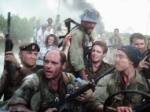 Tom Berenger, Paul Freeman, Jean Francois Stevenin, and JoBeth Williams.
Tom Berenger, Paul Freeman, Jean Francois Stevenin, and JoBeth Williams.
http://www.youtube.com/watch?v=Ji7-p2GMbWA
Hud 1963
Martin Ritt
(3 Oscars)
From Larry McMurty’s novel, Hud is Paul Newman’s cranky cowboy caper. A disappointment to his stalwart, principled father  (Melvyn Douglas), and a hero to his younger brother ( Brandon De Wilde), Hud’s just waiting for his Dad to die so he can inherit the ranch. Patricia Neal is hired to help with the chores, creating some lust amongst the longhorns. And have a listen to Elmer Bernstein’s subtly effective score –
(Melvyn Douglas), and a hero to his younger brother ( Brandon De Wilde), Hud’s just waiting for his Dad to die so he can inherit the ranch. Patricia Neal is hired to help with the chores, creating some lust amongst the longhorns. And have a listen to Elmer Bernstein’s subtly effective score –  sometimes using just one guitar. Newman is one nasty cowpoke, but Douglas and Neal steal the show, and win their Oscars. A Best Cinematography Oscar also went to James Wong Howe for some beautiful work in Black and White.
sometimes using just one guitar. Newman is one nasty cowpoke, but Douglas and Neal steal the show, and win their Oscars. A Best Cinematography Oscar also went to James Wong Howe for some beautiful work in Black and White.
http://www.facebook.com/video/video.php?v=1052301477747
KLUTE
Alan Pakula 1971
(1 Oscar)
Klute was the first installment of what would become known as director Alan Pakula’s “Paranoia Trilogy”. The other two films are “The Parallax View” (1974) and “All the President’s Men” (1976). But, I think most people remember it for Jane Fonda’s once-in-a-lifetime performance (and her Oscar) as the jittery hooker with someone on her roof.
The film begins with the disappearance of Pennsylvania executive Tom Gruneman. The police reveal that an obscene letter was found in Gruneman’s office. It was addressed to a prostitute in New York City named Bree Daniels (Fonda), who had received several similar letters from Gruneman. Much to the surprise of the police, Peter Cable (Cioffi), an executive at Gruneman’s company, hires family friend John Klute (Sutherland) to investigate Gruneman’s disappearance.
Klute rents an apartment in the basement of Daniels’ building, taps her phone, and follows her as she turns tricks. Initially, Daniels appears to be liberated by the freedom of freelancing as a call girl. In visits with a psychiatrist throughout the film, however, she reveals that she feels empty inside and wants to quit. Klute asks Daniels to answer some of his questions, but she refuses. He approaches her again, revealing that he has been watching her. She assumes that he will turn her in if she does not cooperate, but does not recall Gruneman at all. She reveals that she was beaten by one of her ‘johns’ two years earlier, but after seeing a photo of Gruneman, she says she cannot say for sure one way or the other. She is only certain that the john “was serious” about the attack.
Daniels takes Klute to meet her former pimp, Frank Ligourin (Scheider). Ligourin reveals that one of his prostitutes passed off the abusive client to Bree and another woman named Arlyn Page  (Dorothy Tristan). The original prostitute committed suicide, and Page became a junkieand disappeared. Klute gives his surveillance tapes to Daniels, telling her he is finished with her part of the case. But, realizing that he cannot continue the investigation without her, he re-enlists her help to track down Page.
(Dorothy Tristan). The original prostitute committed suicide, and Page became a junkieand disappeared. Klute gives his surveillance tapes to Daniels, telling her he is finished with her part of the case. But, realizing that he cannot continue the investigation without her, he re-enlists her help to track down Page.
Klute is one of the great New York Location movies. Others that come to mind are “Serpico”, “The French Connection”, and “Three Days of the Condor”. From the very first credit, Michael Small’s tingly, eerie musical score sets the mood. Alan Pakula went for dark and gritty, shooting in tight locations where entire scenes were lit exclusively with ‘inkies’. The result is a feeling of intimacy that resonates throughout the film, amplifying a sense of impending danger.
Beyond Fonda’s astounding performance, Donald Southerland’s John Klute has a hound dog-like persistence. Roy Scheider does a creepy turn as Fonda’s pimp, and Charles Cioffi is effectively dangerous as the serial hooker-killer. But, it’s Vivian Nathan, as Fonda’s shrink, who steals the show.
The Prince of Darkness, Gordon Willis, shines here, creating luster in the shadows. Seemless editing by Carl Lerner, and Michael Small’s relentlessly eerie score make this memorable. Maybe you have to be a New Yorker to love this film, but I don’t think so. One of my all time favorites.
Best scenes: Fonda with her ‘trick’ in the hotel room – “Oh, my angel. My angel”. And Jane tells old Mr Goldfarb about her recent erotic adventure. “No, he was an older man, not unlike yourself. Young men can be so…..silly”.
http://www.youtube.com/watch?v=EbWNl5_JT7k
http://www.youtube.com/watch?v=9FgAW344s5w
Lost Horizon 1937
Frank Capra
(2 Oscars)
It was the mid Thirties, and the Faschisti were marching across an ever-darkening Europe. James Hilton’s novel described a better place, a place of peaceful solutions, and escape from the
jack boot – somewhere over the rainbow, or in this case over the Himalaya’s, was the secret valley of the Blue Moon, and at its center – Shangri La, where dreams came true and life was eternal, well almost. In my opinion, Lost Horizon is Frank Capra’s masterpiece, and a joy for anyone to see.
The director didn’t like the early dailies – something just wasn’t right in those snow scenes. And it dawned on Capra, that there was no steaming breath from the mouths of his actors. So he packed up and reshot in a gigantic meat freezer, somewhere in Brentwood.
Tragically, about fifteen minutes of the original negative has been lost. The producers of the now-available DVD offer two versions; one with the existing picture, and another (thank God) with the screenplay intact, and a black picture over the dialogue scenes where the original picture was lost. I found the latter to be preferable, hearing the entire script, for me anyway, was much more satisfying.
A delicious Fairy Tale beautifully delivered by Capra with: Ronald Coleman, Jane Wyatt, Edward Everett Horton, Thomas Mitchell, and Sam Jaffe as The High Lama. And, Dmitri Tiomkin’s luscious musical score.
http://www.tcm.com/mediaroom/index.jsp?cid=223909
http://www.tcm.com/mediaroom/index.jsp?cid=223908
Serpico 1973
Sidney Lumet
Officer Serpico’s best friend on the police force tells him, “Frankie, no one trusts a cop, don’t take money”. From Peter Mass’ book on  New York City’s police corruption, and the true story of the cop who went on record against it. It takes almost the entire film for Serpico to persuade New York’s political establishment to accept the evidence he’s been trying to give them all along – evidence that leads to the Knapp Commission hearings. Director Lumet is
New York City’s police corruption, and the true story of the cop who went on record against it. It takes almost the entire film for Serpico to persuade New York’s political establishment to accept the evidence he’s been trying to give them all along – evidence that leads to the Knapp Commission hearings. Director Lumet is
at home, shooting on location, in the city he knows so well, and the film looks it. Dark and luscious lensing by Arthur Ornitz, and strong ensemble work by an familiar cast, filled with Lumet’s favorite actors. But, in my opinion, the smartest decision Sidney Lumet made was hiring Mikis Theodorakis to do the musical score, music that seems to support every image, with lyrical simplicity. One of the all-time great New York location movies, with: Al Pacino as Officer Frank Serpico, surrounded by the Sidney Lumet repertory company.
http://www.youtube.com/watch?v=LtTRYnsDH8Q
Slapshot 1977
George Roy Hill
Oddly enough I never saw Slapshot in a movie theater. My buddy  Mal Worob had a tape of it in his Manhattan loft. This was even before VHS – it was probably a Betamax. Mal was the first person I knew who had copies of movies at home.
Mal Worob had a tape of it in his Manhattan loft. This was even before VHS – it was probably a Betamax. Mal was the first person I knew who had copies of movies at home.
Anyway, I can remember Paul Newman, in an interview saying, “We got more out of less on Slapshot that any movie I was involved in”.
Newman plays the Player/Coach of a failed minor league Hockey Team, that’s being sold behind his back. So, with nothing to lose, 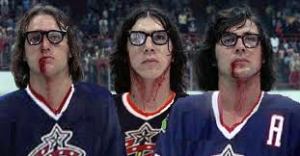 he hires the Hanson brothers (real life hockey players), who are notoriously violent and dirty players, and the Chiefs go on a tear. Slapshot has the look of a film that was obviously fun for the actors involved, and it shows, the cast seemingly in on every gag. And that cast includes Newman, Lindsay Crouse, Strother Mortin, Michael Ontkean, and those effervescent Hanson brothers.
he hires the Hanson brothers (real life hockey players), who are notoriously violent and dirty players, and the Chiefs go on a tear. Slapshot has the look of a film that was obviously fun for the actors involved, and it shows, the cast seemingly in on every gag. And that cast includes Newman, Lindsay Crouse, Strother Mortin, Michael Ontkean, and those effervescent Hanson brothers.
Hilarious!
http://www.youtube.com/watch?v=vW67agGgWAM
The Professionals 1966
Richard Brooks
Another Seven Samurai spin-off, but this one’s got Lee Marvin, and Burt Lancaster, and Robert Ryan, and Woody Strode, and Jack  Palance and Claudia Cardinale, and some of the sauciest, machismo, cowpoke dialogue ever delivered. Richard Brooks’ crusty screenplay constantly parodies itself, and the boys are up to the task. Lee and Burt play tired adventurers, hired for one last mission – bring back the kidnapped wife of a wealthy railroad mogul. They had both fought in Mexico with
Palance and Claudia Cardinale, and some of the sauciest, machismo, cowpoke dialogue ever delivered. Richard Brooks’ crusty screenplay constantly parodies itself, and the boys are up to the task. Lee and Burt play tired adventurers, hired for one last mission – bring back the kidnapped wife of a wealthy railroad mogul. They had both fought in Mexico with
Pancho Villa, and are not eager to ride back south of the border but, what the hell, ten thousand dollars a man buys a lot of tamales. Every actor is given quotable dialogue to deliver, and deliver they do. This movie could have been just silly, but director, script, and cast come together here, and the result is a thoroughly entertaining film. Beautiful cinematography by Conrad Hall, and the musical score, by Maurice Jarre, is unexpectedly spicey. Grab this, if you can.
http://www.youtube.com/watch?v=iE7MSE0bDe8
The Thomas Crown Affair 1968
Norman Jewison
(1 Oscar)
No, not that silly sequel with Pierce Brosnan. I’m talking about the 1968 original with Steve McQueen and Faye Dunaway. A big  bank heist, simply for the thrill of it. A wealthy and bored McQueen robs the biggest bank in Boston, for fun. And insurance investigator Faye Dunaway is hired to crack the case. Of course, this is a movie, so they become romantically and competitively involved. She tells him she’s going to win, and get her man. He takes the challenge, and goes out and robs another bank, basically telling her, “I’m going to do it, and you can’t stop me, or catch me”.
bank heist, simply for the thrill of it. A wealthy and bored McQueen robs the biggest bank in Boston, for fun. And insurance investigator Faye Dunaway is hired to crack the case. Of course, this is a movie, so they become romantically and competitively involved. She tells him she’s going to win, and get her man. He takes the challenge, and goes out and robs another bank, basically telling her, “I’m going to do it, and you can’t stop me, or catch me”.
Sexy, slickly entertaining suds, with two stars in their prime. And, unlike the silly sequel, someone has to win, and someone has to
lose. The chase becomes a chess match, figuratively, and literally. Great use of split-screen, and Michel Legrand’s Oscar winning score, with a great song, “Windmills of your Mind” woven through it. Bank heists, Polo, Glider planes, and Chess for sex. Ah, the Sixties.
http://www.youtube.com/watch?v=hzajlo4ZJ0I
Three Day’s of the Condor 1975
Sidney Pollock
Is there a second CIA, inside the CIA? A question Turner (Robert  Redford), a bookish, reader/researcher who works for the CIA asks himself, after returning from lunch to find everyone in his New York office has been assassinated. The Agency thinks he’s involved, and unknown forces are out to silence him. He needs time to sort it all out, and somewhere to hide.
Redford), a bookish, reader/researcher who works for the CIA asks himself, after returning from lunch to find everyone in his New York office has been assassinated. The Agency thinks he’s involved, and unknown forces are out to silence him. He needs time to sort it all out, and somewhere to hide.  He kidnaps Faye Dunawaye, and uses her apartment – a place to think things through. Everyone is after him. Atwood (Addison Powell) whose secret network Turner accidently uncovered. Higgins (Cliff Robertson), the CIA’s Deputy Director who’s trying to bring him in. Wabash (John Houseman), a CIA Mandarin who orders him killed. Joubert (Max von Sydow) a hired assassin who befriends him. With the help of his kidnap victim Kathy (Faye Dunaway), he tries to solve the puzzle.
He kidnaps Faye Dunawaye, and uses her apartment – a place to think things through. Everyone is after him. Atwood (Addison Powell) whose secret network Turner accidently uncovered. Higgins (Cliff Robertson), the CIA’s Deputy Director who’s trying to bring him in. Wabash (John Houseman), a CIA Mandarin who orders him killed. Joubert (Max von Sydow) a hired assassin who befriends him. With the help of his kidnap victim Kathy (Faye Dunaway), he tries to solve the puzzle.
Condor is a fast paced, top notch CIA spy caper, with a clever, ever-twisting plot, and game cast. Pollock’s second best effort, I think. (Tootsie is hard to beat) Lorenzo Semple’s intelligent screenplay is smart and juicy. Slick cinematography by Owen Roizman, with good use of New York locales. Great stuff.
http://www.youtube.com/watch?v=PBZf7vifXmY
*
© 2011 Shaun Costello
I WISH I’D SAID THAT

I WISH I’D SAID THAT
By Shaun Costello
I’ve always envied those few whose witty weaponry enabled them to defuse an impossible moment with the turn of a phrase.
Sherwood Anderson when reviewing cowboy hero Tom Mix: “They say he rides as if he’s part of the horse, but they didn’t say which part.”
Dorothy Parker: “That woman speaks eighteen languages and can’t say ‘no’ in any of them.”
George S Kaufman: Once asked by a press agent, “How do I get my leading lady’s name into your newspaper?” Kaufman replied, “Shoot her.”
I wish I’d said that, but of course no one asked me. Of all the great verbal kick-turns I’ve read, my favorite happened at a Beverly Hills dinner party back in 1940.
Arthur Hornblow Jr. was one of Hollywood’s most successful producers. From 1933 to 1942 he had a hand in the production of some of Paramount’s 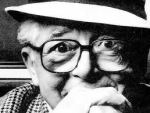 biggest hits, before moving on to a stellar career at MGM, producing for luminaries like George Cukor and Billy Wilder. Hornblow’s fame as a producer was equaled however, by his legendary reputation as a party host. His dinner parties were storied events, and making his guest list meant you had “arrived” in the motion picture community.
biggest hits, before moving on to a stellar career at MGM, producing for luminaries like George Cukor and Billy Wilder. Hornblow’s fame as a producer was equaled however, by his legendary reputation as a party host. His dinner parties were storied events, and making his guest list meant you had “arrived” in the motion picture community.
The massive dining table was set according to the measurements and procedures followed by the staff of the Royal Family for state dinners at Windsor Castle. Each dinner guest was provided with their own personal
servant, who stood at attention behind each chair awaiting the call to the most menial of tasks. The wines served were of the great vintages from the finest Chateau’s of Bordeaux and Burgundy. The guest list read like the who’s who of Hollywood Royalty: Clark Gable, Carole Lombard, Robert  Taylor, Claire Trevor, Spencer Tracy, Kate Hepburn, Jimmy Stewart, Bing Crosby, Olivia DeHaviland, Bob
Taylor, Claire Trevor, Spencer Tracy, Kate Hepburn, Jimmy Stewart, Bing Crosby, Olivia DeHaviland, Bob  Hope, Cary Grant. All dressed to the “Nines”. At their peak. Walking on air.
Hope, Cary Grant. All dressed to the “Nines”. At their peak. Walking on air.
On this particular evening the name of Herman Mankiewicz had been added to the guest list. Manky, as he was universally known, was one of Hollywood’s mercurial talents, responsible for the screenplays for Citizen Kane, The Enchanted Cottage,
Dinner at Eight, and many others. He was also one of Hollywood’s most notorious drunks, leaving a disgruntled and embarrassed list of dinner hosts in his wake. Arthur Hornblow Jr. had avoided inviting Manky to one of his  extravaganzas, fearing bad behavior, and the
extravaganzas, fearing bad behavior, and the 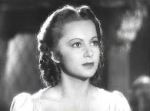 possibility of an unfortunate incident. But Manky, whose barbed wit and scintillating conversation made him popular on Tinseltown’s party circuit, could not be put off forever. So on this particular evening a nervous Arthur Hornblow Jr. could do nothing more than hope for good behavior from his mercurial guest. He gave strict instructions to the staff to limit Manky’s wine service at dinner and to watch for signs of unusual behavior. That done, Hornblow continued fussing over details he felt necessary in order to present a fabulous evening to his fabulous guests.
possibility of an unfortunate incident. But Manky, whose barbed wit and scintillating conversation made him popular on Tinseltown’s party circuit, could not be put off forever. So on this particular evening a nervous Arthur Hornblow Jr. could do nothing more than hope for good behavior from his mercurial guest. He gave strict instructions to the staff to limit Manky’s wine service at dinner and to watch for signs of unusual behavior. That done, Hornblow continued fussing over details he felt necessary in order to present a fabulous evening to his fabulous guests.
The pre-dinner cocktail reception out on the terrace was accompanied by a string quartet, while Hollywood’s finest chattered amongst themselves, totally oblivious to possibility of the existence of anything unglamorous in or out of their own perfect little world. Manky held court with a raconteur’s glib concoction of facts and fables, and his audience loved every moment. Hornblow gazed at the assembly through the window and smiled.
The crystal bell tinkled the announcement of a dinner at the ready, and the guest list with the grace born of celebrity and assurance glided through the huge doorway into the dining chamber, the epicenter of Hornblow’s mansion. Everyone found their appropriate places with Hornblow at the  head of the enormous table, and his wife Myrna Loy sitting opposite. The wines were greeted with ooohs and ahhhs, and each course served was a tour de force in epicurean perfection. Arthur Hornblow Jr, surveyed his table with a sense of satisfaction thinking to himself. “Well Arthur, you’ve done it again. Everything is as it should be.”
head of the enormous table, and his wife Myrna Loy sitting opposite. The wines were greeted with ooohs and ahhhs, and each course served was a tour de force in epicurean perfection. Arthur Hornblow Jr, surveyed his table with a sense of satisfaction thinking to himself. “Well Arthur, you’ve done it again. Everything is as it should be.”
Gone unnoticed amidst all this perfection was an unusually quiet Herman Mankiewicz. Although his wine flow had been curtailed at the dinner table, he had consumed seven or eight martinis during the pre dinner festivities and was plastered. He sat staring straight ahead, weaving ever so slightly to his left and then his right, then slightly forward and suddenly vomited into his soup.
What followed was the longest pause in the history of Tinseltown. No one moved. No one made eye contact with anyone else. Fifty dinner guests sat silent and motionless, perhaps hoping on the off chance, that God might appear and, in his benevolence somehow make things right. But God went unneeded on this particular evening. Manky, seemingly recovered from his trance-like stupor looked down at the evidence of his mischief, then slowly lifted his head and turned in the direction of his horrified host and said, “Not to worry Arthur. The white wine came up with the fish.”
I wish I’d said that. I wish I’d been there.
*
© 2006 Shaun Costello/New York Times Sunday Magazine
TOADY TOBACK’S HASTY EXIT

I think Jimmy Toback sucks, and so should you.
By Shaun Costello
Every once in a great while, an opportunity presents itself to right a great wrong, to set the record straight, to win one for the Gipper. Permit me to give you an example of how I obnoxiously and joyfully behaved when I got the worst of all film directors accidentally in my cross hairs. Some time in 1983, I paid seven dollars to see, arguably, the worst film ever made. It was “Exposed”, starring Nastassia Kinsky (she of the snake pic) and Rudolph Nureyev (I’m not making this up). Anyway, about half way through this excruciatingly putrid film, and just before I walked out of the  theater, Nureyev, who plays a violinist, approaches Nasty Kinsky from behind and, while fingering her face like frets on a fiddle, he begins to run his bow across her bare breasts, as she moans in ecstasy, “Oh yes, play me, play me”.
theater, Nureyev, who plays a violinist, approaches Nasty Kinsky from behind and, while fingering her face like frets on a fiddle, he begins to run his bow across her bare breasts, as she moans in ecstasy, “Oh yes, play me, play me”.
Well, that was just about my limit, and I swore to myself that if I ever ran across that talentless, gambling addicted, over-achiever Jimmy Toback, who directed this piece of drek, that vengeance would be mine.
OK, fast forward to about 1988. I’m sitting with a few friends watching a movie; I don’t remember which one, at the Ziegfeld Theater, which was then Manhattan’s best film venue. After the tail credits, the house lights come up and, as we’re putting on our coats, one of my friends say’s, “Hey, isn’t that Jimmy Toback?” It was one of those Marlon Brando diamond bullet in the forehead moments that come all too infrequently in a man’s life, but I was up to it. At just about the top of my lungs, I screamed across the crowded theater, “Hey Toback, I sat through half an hour of EXPOSED, and you owe me seven bucks, now pay up!” Toback, slime that he was (and I’m sure still is), bolted, running for one of the side doors of the theater, leaving behind the girl he was with. What a toad. Anyway, I’m sure everyone within earshot thought I was nuts, but I felt like a million bucks. Vengeance was finally mine, and the cowardly behavior of Toback just about made my year. The moral of this tale, if there is one, is the next time opportunity knocks – open the door.
http://www.youtube.com/watch?v=EHq6B_EMhks
*
© 2007 Shaun Costello
HOLLYWOOD’S BEST

Hollywood’s Best
The ten best American films I can think of that
were produced by Hollywood’s studio system.
A moment here, to talk about criteria. My selection process was based on those films, whose existence depended on the creative conveyor belt of Hollywood’s film factories, that began with the Silents of the Twenties, and peaked with the well organized, and marvelous output of the Thirties and Forties. The major studios were run by hard nosed businessmen with names like Mayer, and Zanuck, and Warner, and Cohn; whose methods for getting a product to market varied little from their cousins back East, in New York’s Garment Center. Everyone who worked in movies back then was under contract; writers, directors, producers, scenic artists, technicians, and of course, movie stars. The production schedules were tight, and the objective was to get the maximum amount of product to the marketplace, with the minimum amount of time and cost. Scratch a Movie Mogul, and find a Garmento? Sure, why not – the system worked. And, every so often, the right elements fell into place, usually by happenstance, and resulted in memorable motion pictures. The appropriate writer for the script, the right actor for the part, a crew that knew its business, a savvy producer to crack a whip, and the right director, with the vision and stamina to see the project through. And the result was the everlasting language of movies, woven forever into the fabric of the American syllabus. Those lines that live forever: “Of all the gin joints, in all the world”………. “Pay no attention to that man behind the curtain”……….. “Take ‘em to Missouri, Matt”………. “Leave the gun. Take the cannoli’s”………… “I’m on toppa the world, Ma”………. “Frankly my dear, I don’t give a damn”………… “Badges? We don’ need no stinkin’ badges”……….“I coulda been a contender. I coulda been somebody”. American films, produced through the Hollywood Studio System.
I struggled with this, and many of you will find fault with my choices but, for better or worse, here they are:
Red River 1948
Howard Hawks
As American as it gets. Hawks’ memorable tapestry of the blazing of the Chisholm Trail. The cattle were in Texas, but the Rail Head was in Abilene Kansas. And driving a huge and ornery herd of  cattle, for the very first time, across the Red River, over mountain ranges, through hostile Indian territory, risking misadventure with nature and bands of rustlers, was no easy business.
cattle, for the very first time, across the Red River, over mountain ranges, through hostile Indian territory, risking misadventure with nature and bands of rustlers, was no easy business.
Hawks, probably Hollywood’s best dialogue director, made John  Wayne almost believable. Lots of crusty, spicy cowpoke dialogue, that might be corny in the hands of another director, but Hawks pulls it off.
Wayne almost believable. Lots of crusty, spicy cowpoke dialogue, that might be corny in the hands of another director, but Hawks pulls it off.
It’s dawn on the range, and the men and the cattle are ready. Hawks’ camera does a slow, minute-long, 360 pan across the faces of cowboy after cowboy, beginning and ending on Wayne, who looks to Montgomery Clift and finally say’s, “Take ‘em to Missouri, Matt”. Clift raises his hat  and whoops the first of many, and the next cowboy does the same, and in quick cuts now, face after face, whoop after whoop, until, finally driven by the drama of the moment, the music swells, and the herd begins to move. It’s one of the great moments in movie history and, if you haven’t experienced it – shame on you.
and whoops the first of many, and the next cowboy does the same, and in quick cuts now, face after face, whoop after whoop, until, finally driven by the drama of the moment, the music swells, and the herd begins to move. It’s one of the great moments in movie history and, if you haven’t experienced it – shame on you.
http://movieclips.com/S47B-red-river-movie-showdown/
The Treasure of the Sierra Madre 1948
John Huston
(3 Oscars)
Greed and paranoia in the Mexican Mountains. Huston’s masterpiece, and an Oscar for his Dad. Huston wrote the part for  his father, Walter, to play. What gold does to men’s lives. Howard (Houston) foretells of the possibilities of sudden wealth turning men against each other, but Dobbs (Bogart) say’s not him. He’d take only what he needed, and not a bit more. And of course,
his father, Walter, to play. What gold does to men’s lives. Howard (Houston) foretells of the possibilities of sudden wealth turning men against each other, but Dobbs (Bogart) say’s not him. He’d take only what he needed, and not a bit more. And of course,  it’s Dobbs who turns rotten.
it’s Dobbs who turns rotten.
Absolutely perfect from beginning to end, and as good as movies get
http://www.youtube.com/watch?v=vGpvO8JabEc
The Best Years of Our Lives 1946
William Wyler
(7 Oscars)
The War over, three men meet on the transport plane taking them home to Boone City. A middle-aged Army Sargeant (Fredric  March), a decorated Flyboy (Dana Andrews), and a Sailor with hooks for hands (Harold Russell – a real-life vet amputee, who gives a startlingly believable performance). This film was shot in the time which it depicts, and the language, which might seem corny
March), a decorated Flyboy (Dana Andrews), and a Sailor with hooks for hands (Harold Russell – a real-life vet amputee, who gives a startlingly believable performance). This film was shot in the time which it depicts, and the language, which might seem corny  and dated now, is how people spoke back then. The right cast, particularly March and Myrna Loy, the right story, and a savvy director turn this into one of the real champs. Best moment: Dana Andrews in the bomber shell.
and dated now, is how people spoke back then. The right cast, particularly March and Myrna Loy, the right story, and a savvy director turn this into one of the real champs. Best moment: Dana Andrews in the bomber shell.
http://www.youtube.com/watch?v=h3EsNKlB7os
On the Waterfront 1954
Elia Kazan
(8 Oscars)
So, you have to ask yourself, “Were there really commies in  Hollywood, after WWII, and what message were they sending?” Here, Director Elia Kazan, ever embittered by the McCarthy-driven witch hunt that victimized him, certainly serves up a leftist theme, but who cares. Scorching drama, delivered by Brando’s ex pug, Malden’s stalwart Priest, and Cobb’s gangster brother, all delivering Budd Schulberg’s
Hollywood, after WWII, and what message were they sending?” Here, Director Elia Kazan, ever embittered by the McCarthy-driven witch hunt that victimized him, certainly serves up a leftist theme, but who cares. Scorching drama, delivered by Brando’s ex pug, Malden’s stalwart Priest, and Cobb’s gangster brother, all delivering Budd Schulberg’s  crisp, believable dialogue make this one memorable. Also great ensemble work by Kazan’s bit players, some of whom were ex prize fighters and looked it. Overlooked often, is Leonard Bernstein’s simple and haunting score, and Boris Kaufman’s all-to-real, black and white cinematography. If you’ve seen it, see it again. If you haven’t, what are you waiting for?
crisp, believable dialogue make this one memorable. Also great ensemble work by Kazan’s bit players, some of whom were ex prize fighters and looked it. Overlooked often, is Leonard Bernstein’s simple and haunting score, and Boris Kaufman’s all-to-real, black and white cinematography. If you’ve seen it, see it again. If you haven’t, what are you waiting for?
http://www.traileraddict.com/trailer/on-the-waterfront/trailer
Citizen Kane 1941
Orson Welles
(1 Oscar)
The one and only. Movies would never be the same again. The story goes, that it was Nelson Rockefeller (Just who did you think  the ‘R” in RKO was, anyway?), who heard the Mercury Theater of the Air’s now-infamous radio broadcast of War of the Worlds, and called the Studio to suggest bringing this young radio guy, Welles, out to Hollywood for a look. So, Welles’ Mercury Theater of the Air troupe moved out to Los Angeles, and the rest is history.
the ‘R” in RKO was, anyway?), who heard the Mercury Theater of the Air’s now-infamous radio broadcast of War of the Worlds, and called the Studio to suggest bringing this young radio guy, Welles, out to Hollywood for a look. So, Welles’ Mercury Theater of the Air troupe moved out to Los Angeles, and the rest is history.
 “Rosebud” – what was it, anyway. From the opening Newsreel, to the screening room scene, to a life revealed, every moment dazzles. Innovations, one after the other – from Greg Toland’s mesmerizing lens, to the rapid fire editing, to Welles’ brilliant direction, to the debut of all those newbie’s from radio – it was all so new and fresh. The screenplay, by Welles and Herman Mankiewicz, has two camps; critic Pauline Kael whose
“Rosebud” – what was it, anyway. From the opening Newsreel, to the screening room scene, to a life revealed, every moment dazzles. Innovations, one after the other – from Greg Toland’s mesmerizing lens, to the rapid fire editing, to Welles’ brilliant direction, to the debut of all those newbie’s from radio – it was all so new and fresh. The screenplay, by Welles and Herman Mankiewicz, has two camps; critic Pauline Kael whose 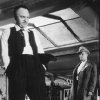 expository essay “Raising Kane”, suggests Manky to be the prime mover, with Welles making additions here and there. Peter Bogdanovich, whose response to Kael was his own essay, “Kane Mutiny”, published in Esquire, refuted Kael’s claims. Years later, it was revealed that Bogdanovich’s piece was actually penned by Welles. Who cares, really? The film’s the thing, and there’s just nothing like it.
expository essay “Raising Kane”, suggests Manky to be the prime mover, with Welles making additions here and there. Peter Bogdanovich, whose response to Kael was his own essay, “Kane Mutiny”, published in Esquire, refuted Kael’s claims. Years later, it was revealed that Bogdanovich’s piece was actually penned by Welles. Who cares, really? The film’s the thing, and there’s just nothing like it.
http://www.youtube.com/watch?v=zyv19bg0scg
The Wizard of Oz 1939
Victor Fleming
(2 Oscars)
Well, because! Because of the wonderful things he does. I wanted to include a musical, and no other Hollywood Musical matches  Dorothy’s magical tornado-assisted journey from Kansas to Oz, and back again. Nothing even comes close. It’s as fresh and appealing to children today, as it was when it first opened seventy years ago. Seventy years – hard to imagine. Garland, and Bolger, and Lahr, and Haley, and Frank Morgan’s Wizard, and Magaret Hamilton’s Wicked Witchiness, and Billie Burke’s Glinda. And all those Munchkins, who live
Dorothy’s magical tornado-assisted journey from Kansas to Oz, and back again. Nothing even comes close. It’s as fresh and appealing to children today, as it was when it first opened seventy years ago. Seventy years – hard to imagine. Garland, and Bolger, and Lahr, and Haley, and Frank Morgan’s Wizard, and Magaret Hamilton’s Wicked Witchiness, and Billie Burke’s Glinda. And all those Munchkins, who live 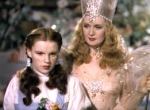 Somewhere, Over the Rainbow. It’s just all so perfect, and it made the world a better place.
Somewhere, Over the Rainbow. It’s just all so perfect, and it made the world a better place.
http://www.traileraddict.com/trailer/the-wizard-of-oz/trailer
Nashville 1975
Robert Altman
(1 Oscar)
I’ll bet I surprised you with this one. Altman’s scathingly hilarious take on Country Music, and the shrine it lives in. The  word got out, Robert Altman was on location shooting some kind of musical, and he was letting the cast members write their own songs. Well, that’s about all it took for actors from Altman’s older films to start showing up on the set. And Altman wrote them in, playing themselves, and they improvised their scenes with other cast members. Julie
word got out, Robert Altman was on location shooting some kind of musical, and he was letting the cast members write their own songs. Well, that’s about all it took for actors from Altman’s older films to start showing up on the set. And Altman wrote them in, playing themselves, and they improvised their scenes with other cast members. Julie  Christie and Elliot Gould were among them. It was a chaotically joyful atmosphere.
Christie and Elliot Gould were among them. It was a chaotically joyful atmosphere.
OK, during a political campaign in the city of Nashville, the story drifts lazily through the lives of several of its citizens – some musicians, some wannabe’s, and some just plain folks. The vignettes are so absorbing, and the music so great, that it doesn’t seem to matter that the movie seems to have no central theme – but it does. Incredible performances by an insane Barbara Harris, and far too many actors to name. Just about the time when you begin wondering  what this thing is all about (we’re now almost two hours into it with no apparent story in sight), all of the characters converge at the site of a political rally. And then it happens – someone we’ve known all along, unexpectedly pulls out a gun and starts shooting. And cast members start falling. And in the midst of chaos, the craziest member in the cast, Barbara Harris, a wannabe lounge singer with no voice, picks up the microphone and begins to sing, somehow calming the terrified onlookers. Nashville Is an eyeful and an earful, but most of all, it’s joyfully entertaining.
what this thing is all about (we’re now almost two hours into it with no apparent story in sight), all of the characters converge at the site of a political rally. And then it happens – someone we’ve known all along, unexpectedly pulls out a gun and starts shooting. And cast members start falling. And in the midst of chaos, the craziest member in the cast, Barbara Harris, a wannabe lounge singer with no voice, picks up the microphone and begins to sing, somehow calming the terrified onlookers. Nashville Is an eyeful and an earful, but most of all, it’s joyfully entertaining.
http://www.youtube.com/watch?v=9SeotkeSfp8
Network 1976
Sidney Lumet
(4 Oscars)
“I’m mad as hell, and I ‘m not going to take it any more”. So say’s  Howard Beale, former Mandarin of television, and currently the madman of the airwaves. Lumet’s crafty direction, pretty much letting his cast do their thing, comes in second here, to what may be the greatest screenplay ever written. Paddy Chayevsky’s brilliantly prophetic script foresaw the future of television. In
Howard Beale, former Mandarin of television, and currently the madman of the airwaves. Lumet’s crafty direction, pretty much letting his cast do their thing, comes in second here, to what may be the greatest screenplay ever written. Paddy Chayevsky’s brilliantly prophetic script foresaw the future of television. In  painting a picture of a television network gone mad, he basically created Fox News, long before Rupert Murdoch ever wrote the check. A sexy cast, including William Holden, Faye Dunaway, Peter Finch, Robert Duvall, and Ned Beatty in a scene you’ll never forget.
painting a picture of a television network gone mad, he basically created Fox News, long before Rupert Murdoch ever wrote the check. A sexy cast, including William Holden, Faye Dunaway, Peter Finch, Robert Duvall, and Ned Beatty in a scene you’ll never forget.
http://www.youtube.com/watch?v=CeCMSLP3Wy8
The Godfather 1972
Francis Ford Coppola
(3 Oscars)
The Godfather Part Two
Francis Ford Coppola
(6 Oscars)
Ok, I know I’m cheating here, but I’m going to combine them as  one movie. I didn’t want the Godfather Saga taking up twenty percent of the list. Find forgiveness in your heart. Vito Corleone’s clan seems to take up more than its share of space in the American psyche. Part Two may be an even better movie than its predecessor. From Clemenza’s “Leave the gun, Take the cannoli’s”, to Hyman Roth’s “Michael,
one movie. I didn’t want the Godfather Saga taking up twenty percent of the list. Find forgiveness in your heart. Vito Corleone’s clan seems to take up more than its share of space in the American psyche. Part Two may be an even better movie than its predecessor. From Clemenza’s “Leave the gun, Take the cannoli’s”, to Hyman Roth’s “Michael,  we’re bigger than US Steel”, it’s a marvelous narrative of two generations of a Mafia crime family. Really, picture perfect in every way. Coppola’s all-seeing eye seems everywhere, in every detail, no matter how small. He brought the A-Team to this one, from Gordon Willis’ dark images to Nino Rota’s music. Splendid!
we’re bigger than US Steel”, it’s a marvelous narrative of two generations of a Mafia crime family. Really, picture perfect in every way. Coppola’s all-seeing eye seems everywhere, in every detail, no matter how small. He brought the A-Team to this one, from Gordon Willis’ dark images to Nino Rota’s music. Splendid!
http://www.youtube.com/watch?v=bf16Vc3iZjE
http://www.youtube.com/watch?v=DLMg25_-EXk
http://www.youtube.com/watch?v=qJr92K_hKl0
Casablanca 1942
Michael Curtiz
You must remember this. Hollywood’s greatest accident, and maybe the all-time most perfect script. Just a production number  on Jack Warner’s long list of propaganda projects for Washington, but somehow, everything fell into place. Bogart and Bergman, who seldom spoke to each other off-camera, and never struck up a friendship, came off as perhaps the most romantic couple in the history of movies. Warner’s stock company filled out the cast perfectly, and that song – As Time Goes By. Assigned to write the screenplay, totally by happenstance, were those happy go lucky Epstein twins, Julius
on Jack Warner’s long list of propaganda projects for Washington, but somehow, everything fell into place. Bogart and Bergman, who seldom spoke to each other off-camera, and never struck up a friendship, came off as perhaps the most romantic couple in the history of movies. Warner’s stock company filled out the cast perfectly, and that song – As Time Goes By. Assigned to write the screenplay, totally by happenstance, were those happy go lucky Epstein twins, Julius  and Philip, who would pen perfection, much to their own surprise. From top to bottom, no one had any idea that this little propaganda vehicle would wind up to be one of Hollywood’s greatest classics.
and Philip, who would pen perfection, much to their own surprise. From top to bottom, no one had any idea that this little propaganda vehicle would wind up to be one of Hollywood’s greatest classics.
But there was a problem. The edited film made no sense. Jack Warner hated it, and said it was unfixable. Editor Owen Marks sat there with Director Michael Curtiz trying every trick he could think of. It was the ending. Bogart sends Bergman off with Henreid to the waiting plane. Major Strasser shows up and is shot by Claude Raines, much to Bogey’s surprise. But it doesn’t seem to make any sense. Warner drags the Epstein boys off their tennis court and orders them into the editing room. When they see the ending they’re stunned. “What have you done to our script?”, they ask Curtiz and Marks. Julius Epstein tells Marks to reverse the order of two close-up reaction takes during the end of the scene. Voila, a classic is born. And the Epsteins return to their tennis game. The Fundamental things apply, as time goes by.
http://www.youtube.com/watch?v=INBmVxAsdFE
*
© 2011 Shaun Costello
MY TEN FAVORITE EUROPEAN FILMS

MY TEN FAVORITE EUROPEAN FILMS
(This morning, anyway)
8 and 1/2 1963
Fellini
Probably my all-time fave film, period. Responsibility visited, and avoided at all cost. Oh, that Guido.
Grand Illusion 1937
Jean Renoir
When asked to name his ten favorite movies, Orson Welles replied. “Oh, that’s easy, Grand Illusion, and nine others”.
The Bicycle Thief 1948
Vittorio DeSica
DeSica’s poignant look at a father and son in ravaged post-war Rome.
The Discreet Charm of the Bourgeoisie 1972
Luis Bunuel
Bunuel’s love affair with, and hilarious take on the Bourgeoisie – what they do, what they say, how they think – If they do, if they say, if they think. A surreal comedy – the Bunuel way.
Breathless 1960
Jean-Luc Godard
Belmondo and Seberg, on the run. Sometimes silly, often dazzling. Godard’s best, I think. And, the best of the French New Wave.
L’Avventura 1960
Michelangelo Antonioni
Gilligan’s Island for grown-ups.
Beauty and the Beast 1946
Jean Cocteau
Well, you know the story. Cocteau’s masterpiece, and lovely to look at. Say, is that wall moving?
Mr. Hulot’s Holiday 1953
Jacques Tati
The hapless Hulot heads for the seashore. A delightful comedy in mime, with an elastic Tati surviving one catastrophic situation after another. My two fave scenes are The Train Station, and that Taffy that never quite reaches the sand.
Claire’s Knee 1970
Eric Rohmer
At an alpine lake resort, a 35 year old Jerome is struck dumb by teenage Claire. If he could just touch her knee, maybe that would be enough. Sensually photographed by Nestor Almendros, this is Rohmer’s best effort, I think. An intelligent film, meant for an intelligent audience.
Metropolis 1927
Fritz Lang
Lang’s silent sci-fi dazzler. Hard to imagine now, the audience’s reaction in 1927, to these visionary images. Many have not scene this – don’t be one of them.
*
© 2011 Shaun Costello
SIC SEMPER TYRANNUS

SIC SEMPER TYRANNUS
Surviving Catholic Education
By Shaun Costello
This story is excerpted from my childhood memoir
THE LAST TIME I SAW JESUS
Surviving God and Elvis in the time of ‘Duck and Cover’
I suppose I could blame all subsequent events, and ill advised decisions I made in my life on the eight years I spent as a victim of the Sisters of the Immaculate Conception, but I don’t. I sensed, even as a child, that they were no more or less than a necessary evil (at least my parents thought they were necessary) placed in my path to overcome by what whatever means was at my disposal. Back then little thought was given by Catholic families regarding their participation in the selection process available to them in choosing a primary school for their children. They just found the nearest Catholic school, packed a lunch, and off we went. Off to the welcoming arms of a sociopathetic cult of psychological  misfits who had been cloistered away from the evils of an all too real world that, even on their best days, they seemed powerless to inhabit. During my eight years of ecclesiastical incarceration I never saw anyone who remotely resembled Ingrid Bergman, not to mention Father Crosby.
misfits who had been cloistered away from the evils of an all too real world that, even on their best days, they seemed powerless to inhabit. During my eight years of ecclesiastical incarceration I never saw anyone who remotely resembled Ingrid Bergman, not to mention Father Crosby.
Early on, I came to the conclusion that the two most important elements in a Catholic education were penmanship, and lining up in silence. Ball point pens were strictly forbidden, because only a  true fountain pen could produce the perfect script demanded by the good sisters. As for the silent line up, the merry cacophony of lunchtime playground mischief came to an abrupt halt the moment the dour penguin shook her hand bell. The
true fountain pen could produce the perfect script demanded by the good sisters. As for the silent line up, the merry cacophony of lunchtime playground mischief came to an abrupt halt the moment the dour penguin shook her hand bell. The  shuffle of feet was the only sound as the children found their classmates and silently lined up, awaiting the signal to march off to an afternoon’s lesson in history, which probably included the torture and martyrdom of Saint Isaac Jogues at the hands of the evil Huron Indians. They pulled out his fingernails, and he would not renounce his faith. They pulled out his toenails, and he would not renounce his faith. They gouged out his eyes, and he still would not renounce his faith. Finally, an exasperated Big Chief Huron, fed up with Isaac’s saintliness, cut out his heart and ate it, hoping to ingest some of the holy man’s courage. And old Isaac stood there, bound and gagged, without fingernails or toenails, a big hole in his chest where his heart used to be, and Big Chief Huron, picking pieces of Isaac’s aorta from between his teeth, again demanded spiritual surrender. Not this
shuffle of feet was the only sound as the children found their classmates and silently lined up, awaiting the signal to march off to an afternoon’s lesson in history, which probably included the torture and martyrdom of Saint Isaac Jogues at the hands of the evil Huron Indians. They pulled out his fingernails, and he would not renounce his faith. They pulled out his toenails, and he would not renounce his faith. They gouged out his eyes, and he still would not renounce his faith. Finally, an exasperated Big Chief Huron, fed up with Isaac’s saintliness, cut out his heart and ate it, hoping to ingest some of the holy man’s courage. And old Isaac stood there, bound and gagged, without fingernails or toenails, a big hole in his chest where his heart used to be, and Big Chief Huron, picking pieces of Isaac’s aorta from between his teeth, again demanded spiritual surrender. Not this  time Tonto. The old man simply shook his head in a bold expression of saintly triumph over the heathen redskin. Tears in her eyes, Sister Immaculata stopped reading and put down the third grade American History text from which she had read this lesson in God’s victory over the great unwashed.
time Tonto. The old man simply shook his head in a bold expression of saintly triumph over the heathen redskin. Tears in her eyes, Sister Immaculata stopped reading and put down the third grade American History text from which she had read this lesson in God’s victory over the great unwashed.
It was at this point that she noticed the behavior of three arch criminals; myself, Jim Freeney, and Joe Arrico, who had obviously paid no attention to this valuable lesson and instead, had been engaged in spitball wars in the back row. With these three felons in tow, Sister Immaculata made haste for the music room, where every afternoon the Fur Elise was played badly for hours. The music room doubled as punishment chamber during school hours, and was the only room in the building where nuns noticeably smiled. The young  hooligans were instructed to lean against the wall with the backs of their legs extended, awaiting Sister’s caress. Reaching into the closet, Sister Immaculata took out a pointer. It was 36 inches long, round, and pointed at the tip, resembling almost exactly the canes used to administer corporal punishment in the third world, much to the horror of self righteous Americana. It came down with a loud whack on the back of poor Joe Arrico’s thigh, as he screamed in pain and begged her to stop. She ignored
hooligans were instructed to lean against the wall with the backs of their legs extended, awaiting Sister’s caress. Reaching into the closet, Sister Immaculata took out a pointer. It was 36 inches long, round, and pointed at the tip, resembling almost exactly the canes used to administer corporal punishment in the third world, much to the horror of self righteous Americana. It came down with a loud whack on the back of poor Joe Arrico’s thigh, as he screamed in pain and begged her to stop. She ignored  his screaming pleas and promises of good behavior, and the pointer came down again. I’m not sure how many times she hit him, but it was several, and all the time she smiled. Her screaming, pleading victim was nine years old. Jim Freeney was next with the same result. When it came my turn I was half way to the door before she caught on to the fact that I was not going to be this woman’s pointer fodder. Safely through the door I ran down the hall and all the way home.
his screaming pleas and promises of good behavior, and the pointer came down again. I’m not sure how many times she hit him, but it was several, and all the time she smiled. Her screaming, pleading victim was nine years old. Jim Freeney was next with the same result. When it came my turn I was half way to the door before she caught on to the fact that I was not going to be this woman’s pointer fodder. Safely through the door I ran down the hall and all the way home.
Out of breath, I told my mother what had happened, and her reaction was puzzling. She told me that Sister was always right, and that I must have done something to deserve the punishment I had escaped, and that the only course open to me was to go right back to school, lean on that music room wall and take my punishment like the little criminal I undoubtedly was. I refused. This resulted in a tumultuous few days between my family and the school which, after some posturing, was legally bound to take me back, even though I had not behaved up to the standard of the church’s willing martyrs. Isaac, eat your heart out, or someone else will.
 The daily routine at Our Lady Queen of Martyrs school began at 8:30AM, as children began assembling in the school’s playground. At precisely 8:45, each and every morning, Sister’s hand bell would announce the end of playground hi-jinks, and the beginning of the serious business of lining up in silence. The children lined up by class, and began the silent shuffle into the school building, with the little ones entering first, and the eighth graders bringing up the rear.
The daily routine at Our Lady Queen of Martyrs school began at 8:30AM, as children began assembling in the school’s playground. At precisely 8:45, each and every morning, Sister’s hand bell would announce the end of playground hi-jinks, and the beginning of the serious business of lining up in silence. The children lined up by class, and began the silent shuffle into the school building, with the little ones entering first, and the eighth graders bringing up the rear.
There was a uniform dress code at the school. Boys wore navy blue trousers, a white long sleeved shirt, and a navy blue tie, usually restrained by a tie clasp. Competition for the coolest tie clasp was intense. Girls wore blue jumpers, a white short sleeved blouse, and navy blue knee socks. The supreme beings at the school, the eighth graders, were distinguished from the rest of the lower flotsam by the addition of blue blazers for the boys, and some kind of pin, probably something like “The Order of the Eternal Virgin” for the girls. Eighth graders were looked up to by the rest of us as perfect examples of children who, through diligence and prayer, walked in lock step with the Holy Trinity. They were also bigger than we were and stole our baseball cards and lunch money, but I guess that’s another issue.
Children at Our Lady Queen of Martyrs were divided into three separate and distinct groups. The first were God’s favorites. These  kids all had 98 academic averages, spotless uniforms, heavenly singing voices, inkless fingers, wrote in perfect script, got the best parts in the school play, made speeches at school assemblies, and were generally thought of by the faculty as, “Saints of the Future.” The second group were the kids that God tolerated. They were probably not heaven bound but, through hard work and sacrifice, they might just make it to the
kids all had 98 academic averages, spotless uniforms, heavenly singing voices, inkless fingers, wrote in perfect script, got the best parts in the school play, made speeches at school assemblies, and were generally thought of by the faculty as, “Saints of the Future.” The second group were the kids that God tolerated. They were probably not heaven bound but, through hard work and sacrifice, they might just make it to the  next level; even though they had ink stained fingers, couldn’t remember latin lyrics, spent too much time looking out the window, wrote illegibly, occasionally suffered from “ring around the collar”, were easily confused by the rituals of the Catholic Liturgy, and would probably wind up mowing the lawns of the “Saints of the Future.” Then there was the third group. These were the kids to whom God’s back was turned. The lepers of the Liturgy. They had no shot whatsoever at salvation, and were destined for the big barbeque, to burn in the fires of hell for all eternity. They had dirty finger nails, unkempt hair, ink
next level; even though they had ink stained fingers, couldn’t remember latin lyrics, spent too much time looking out the window, wrote illegibly, occasionally suffered from “ring around the collar”, were easily confused by the rituals of the Catholic Liturgy, and would probably wind up mowing the lawns of the “Saints of the Future.” Then there was the third group. These were the kids to whom God’s back was turned. The lepers of the Liturgy. They had no shot whatsoever at salvation, and were destined for the big barbeque, to burn in the fires of hell for all eternity. They had dirty finger nails, unkempt hair, ink  stains covering their hands and clothes, had close relatives who spoke a foreign languge, ate paste in art class, threw up in hallways, had no reverence for the sainthood, and were to be generally pitied as hopeless creatures, destined for a life outside of God’s plan.
stains covering their hands and clothes, had close relatives who spoke a foreign languge, ate paste in art class, threw up in hallways, had no reverence for the sainthood, and were to be generally pitied as hopeless creatures, destined for a life outside of God’s plan.
I guess that I was a member of group number two; tolerated by God, a distant possibility for salvation, a perpetrator of the ink stain, a barely average student, and a liturgical numbskull, but if I played my cards right I just might make it to the next level, wherever that was.
As kids filtered into their classrooms, the first stop was the Cloak Room. This was a large closet in the back, the full width of the classroom (about thirty feet) and about six feet deep, lined with shelves, under which were coat hooks, and plenty of space to deposit lunch boxes, galoshes, and whatever else kids brought to school. No one wore cloaks of course, but that’s what the sisters  called it, so we did too. The hanging up of hats and coats was followed by a short but robust period of hair pulling, name calling, tripping, strangling, head locking, eye gouging, and general mayhem, after which the little innocents would emerge from the cloak room ready for a morning of inspiration and enlightenment, much to the delight of the good sisters.
called it, so we did too. The hanging up of hats and coats was followed by a short but robust period of hair pulling, name calling, tripping, strangling, head locking, eye gouging, and general mayhem, after which the little innocents would emerge from the cloak room ready for a morning of inspiration and enlightenment, much to the delight of the good sisters.
The school building, a kind of quasi American gothic structure, had eight classrooms of identical size and layout. The classrooms 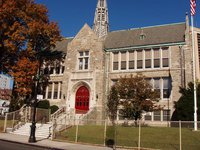 were large, about 60×30, with three walls covered with blackboards and one with windows. About six rows of desks, ten deep, all faced Sister’s large wooden desk, which was centered in front of the class. A student/teacher ratio of 60 to 1. Tough numbers. The student’s desks had hinged tops, allowing for storage inside, an indentation at the front where pencils and pens could lie undisturbed, and a working inkwell. No one really used the inkwells, other than for pranks, but they had always been there, so there they would stay. Until the day when Petey Cataldo, a kid who didn’t talk much and threw up a lot, pissed in each and
were large, about 60×30, with three walls covered with blackboards and one with windows. About six rows of desks, ten deep, all faced Sister’s large wooden desk, which was centered in front of the class. A student/teacher ratio of 60 to 1. Tough numbers. The student’s desks had hinged tops, allowing for storage inside, an indentation at the front where pencils and pens could lie undisturbed, and a working inkwell. No one really used the inkwells, other than for pranks, but they had always been there, so there they would stay. Until the day when Petey Cataldo, a kid who didn’t talk much and threw up a lot, pissed in each and  every inkwell in our class. Sixty inkwells is a lot of piss, and there were many versions of Petey’s triumph. One had Petey sneaking in after school and actually pissing in all our inkwells. The other, and generally accepted version, had Petey peeing in a container for a week. Then when he felt he had enough for the job at hand, he slipped into school after closing, and filled all the inkwells with the product of his efforts. Anyway, no one ever saw Petey again. The rumor was that he had been sent to some kind of special school for kids who threw up a lot. Another rumor had him incarcerated in an institution for recalcitrant Catholics, but no one really believed that. His image lived on in the folklore of the school as a revered personage, a crusader, the boy who had an answer. Of course none of us knew what the question had been, but that didn’t matter. Petey had guts, and for us that was enough.
every inkwell in our class. Sixty inkwells is a lot of piss, and there were many versions of Petey’s triumph. One had Petey sneaking in after school and actually pissing in all our inkwells. The other, and generally accepted version, had Petey peeing in a container for a week. Then when he felt he had enough for the job at hand, he slipped into school after closing, and filled all the inkwells with the product of his efforts. Anyway, no one ever saw Petey again. The rumor was that he had been sent to some kind of special school for kids who threw up a lot. Another rumor had him incarcerated in an institution for recalcitrant Catholics, but no one really believed that. His image lived on in the folklore of the school as a revered personage, a crusader, the boy who had an answer. Of course none of us knew what the question had been, but that didn’t matter. Petey had guts, and for us that was enough.
Throughout the morning the subjects taught by Sister would change at Sister’s whim. In the middle of a History lesson, Sister would suddenly announce,” We will now take out our Arithmetic textbooks.” And this was sister’s segue to the world of mathematics. As the big institutional clock on the classroom wall neared 12 noon all eyes followed the second hand, until that magical moment that happened each and every school day at exactly noon, when the opening chords of the most famous of all John Philip Sousa Marches would play at a decible level that could have awakened the Saints from their eternal sleep, the classroom doors were thrown open and the lunchtime march of the children would begin. Three hundred little kiddies for Christ would stomp down the stairwells and hallways of the school until they were deposited, music still playing, outside the huge front doors, to the delight and chagrin of the terrified lunch counters of Austin Street.
Austin Street was the main commercial drag in Forest Hills. Supermarkets, clothing stores, Woolworths Five and Dime, the Cameo Bowling Alley, drug stores, florists, Pinsky’s Stationary, a travel agency, Glindermann’s German Delicatessen, Vincent’s Shoe Repair, and various spots where lunch could be had cheaply, if you knew what to order. Most kids brought their own lunch to school in little metal lunch boxes. A peanut butter and jelly sandwich, and a banana, or maybe a few cookies, was pretty typical. The school provided half pint containers of milk, free of charge, to kids who brought their own lunch. If you had some money in your pocket, Austin Street’s menu was varied. The  Sutton Hall Pharmacy offered an order of rye toast for 10 cents which could be washed down with a lemon coke, also priced at 10 cents. The newly opened Pizza Prince offered a slice for 20 cents, but kids were still suspicious of pizza. The various lunch counters along the Street offered a variety of cheap filler. An order of french fries was 20 cents, cream cheese on date nut bread could be had for as much as 40 cents, a burger with a hole in the middle from White Tower was a quarter, and various other offerings were priced accordingly. If you were really flush, and I’m talking over a
Sutton Hall Pharmacy offered an order of rye toast for 10 cents which could be washed down with a lemon coke, also priced at 10 cents. The newly opened Pizza Prince offered a slice for 20 cents, but kids were still suspicious of pizza. The various lunch counters along the Street offered a variety of cheap filler. An order of french fries was 20 cents, cream cheese on date nut bread could be had for as much as 40 cents, a burger with a hole in the middle from White Tower was a quarter, and various other offerings were priced accordingly. If you were really flush, and I’m talking over a  dollar here, and you were up for some serious adventure, Austin Street offered “Hamburger Express”. A huge success from the day it opened, “Hamburger Express” delivered your Burger DeLux Platter right to your hungry little face on the flatbed rolling stock of Lionel model trains. The walls were covered with train posters and train photographs, and along the inside part of the counter ran the tracks themselves. The tracks that carried the trains that towed the flatbed cars that brought your lunch. The waitresses wore little train engineer caps that said “Hamburger Express” across the brim, and train whistles and bells and authentic trainlike noises of all sorts could be heard throughout the place. If you could afford it “Hamburger Express” was definitely the lunchtime venue of choice.
dollar here, and you were up for some serious adventure, Austin Street offered “Hamburger Express”. A huge success from the day it opened, “Hamburger Express” delivered your Burger DeLux Platter right to your hungry little face on the flatbed rolling stock of Lionel model trains. The walls were covered with train posters and train photographs, and along the inside part of the counter ran the tracks themselves. The tracks that carried the trains that towed the flatbed cars that brought your lunch. The waitresses wore little train engineer caps that said “Hamburger Express” across the brim, and train whistles and bells and authentic trainlike noises of all sorts could be heard throughout the place. If you could afford it “Hamburger Express” was definitely the lunchtime venue of choice.
 The boys at Our Lady Queen of Martyrs knew about trains. They knew from their earlier days in The Painted Mountains, where they buried their compadres in the Cemetery of unnamed men. They lived without food and water, and became tempered like steel; sinewy leathery boys, whose sole purpose in life was blowing up trains for Pancho Villa, and the glory of the revolution. They knew just how many sticks of dynamite it took to blow a munitions train to hell and gone. And just how many toothpicks it took to cause a derailment that would dump a
The boys at Our Lady Queen of Martyrs knew about trains. They knew from their earlier days in The Painted Mountains, where they buried their compadres in the Cemetery of unnamed men. They lived without food and water, and became tempered like steel; sinewy leathery boys, whose sole purpose in life was blowing up trains for Pancho Villa, and the glory of the revolution. They knew just how many sticks of dynamite it took to blow a munitions train to hell and gone. And just how many toothpicks it took to cause a derailment that would dump a  Cheeseburger DeLuxe into some unsuspecting woman’s lap. These boys knew about trains. And how to stop them.
Cheeseburger DeLuxe into some unsuspecting woman’s lap. These boys knew about trains. And how to stop them.
Finally, “Hamburger Express”, in an effort to keep their trains on the tracks, and to put a stop to the mischief of the boys from the Painted Mountains, hired its own security guard. They dressed him up as a train engineer, and although he greeted customers as they came in, and his demeanor was friendly, even jovial, he was definitely railroad security. This new addition created a more challenging atmosphere. And if that wasn’t enough, possible anti railroad weaponry; ketchup, mustard, toothpicks, pickles, were all removed from the counter until the arrival of your meal, and scooped up the minute they were used. These, and other counter-revolutionary tactics were employed by management in an all- out effort to put a stop to the work of Pancho Villa’s little heros. Additional security didn’t stop Butch and Sundance, and by God it wouldn’t stop Villa’s boys. So, like their days back in the Painted Mountains, they simply brought their own stuff. Toothpicks, gum, silly putty, pencils were all imported from home. And with the advent of watchful railroad security, diversionary tactics were required, usually in the form of a vomiting boy. A kid throwing up in a restaurant was very bad for business, so the boy who was
out effort to put a stop to the work of Pancho Villa’s little heros. Additional security didn’t stop Butch and Sundance, and by God it wouldn’t stop Villa’s boys. So, like their days back in the Painted Mountains, they simply brought their own stuff. Toothpicks, gum, silly putty, pencils were all imported from home. And with the advent of watchful railroad security, diversionary tactics were required, usually in the form of a vomiting boy. A kid throwing up in a restaurant was very bad for business, so the boy who was  assigned the job of “Diversion Puker” was picked up by the railroad security guy the minute he pretended to throw up on the counter, and carried outside to the sidewalk. With security outside, the bedlam of the entire revolution was free to take place right there inside “Hamburger Express”. Four to five derailments could happen in a matter of seconds, with burgers, milkshakes, banana Splits, and lemon cokes all flying helter-skelter, from their respective flatbeds to the laps of unsuspecting and shrieking customers, as total chaos reigned supreme in the little restaurant. Villa’s vigilantes had struck again.
assigned the job of “Diversion Puker” was picked up by the railroad security guy the minute he pretended to throw up on the counter, and carried outside to the sidewalk. With security outside, the bedlam of the entire revolution was free to take place right there inside “Hamburger Express”. Four to five derailments could happen in a matter of seconds, with burgers, milkshakes, banana Splits, and lemon cokes all flying helter-skelter, from their respective flatbeds to the laps of unsuspecting and shrieking customers, as total chaos reigned supreme in the little restaurant. Villa’s vigilantes had struck again.
 With the revolution going well, it was time to return to Our Lady Queen of Martyrs for an afternoon of guessing just how many
With the revolution going well, it was time to return to Our Lady Queen of Martyrs for an afternoon of guessing just how many  arrows Saint Sebastian was stuck with, and what it all meant anyway. At exactly 3 PM the Sousa march would begin, the classroom doors would be thrown open and the afternoon version of “The March of the Children” would take place. The daily schedule at OLQM was identical except for Wednesdays. On Wednesdays class would end at 2:30 and the entire student body would be marched a short distance to the church, where something mysterious called Benediction took place. This was a wealthy parish and the church looked it. The building was a kind of neo gothic mini-cathedral, with pictures and statues of people with their internal organs revealed, and candles burning everywhere. The shared public Catholic ritual is a theatrical assault on the senses, and Benediction was a perfect example. The church’s altar was
arrows Saint Sebastian was stuck with, and what it all meant anyway. At exactly 3 PM the Sousa march would begin, the classroom doors would be thrown open and the afternoon version of “The March of the Children” would take place. The daily schedule at OLQM was identical except for Wednesdays. On Wednesdays class would end at 2:30 and the entire student body would be marched a short distance to the church, where something mysterious called Benediction took place. This was a wealthy parish and the church looked it. The building was a kind of neo gothic mini-cathedral, with pictures and statues of people with their internal organs revealed, and candles burning everywhere. The shared public Catholic ritual is a theatrical assault on the senses, and Benediction was a perfect example. The church’s altar was  fronted by a large proscenium, pretty much like the stage at Radio City Music Hall, where men wearing colorful satin outfits spoke, chanted, and sang in a dead language, and shook ornate little balls filled with incense (usually frankincense or myrrh), as the organ began the prelude to yet another hymn in Latin. I have no more clue today, than I did back then, as to the meaning or significance of Benediction, but I never forgot the music. The main hymn was something called “Tantum Ergo” and, although, at the time, I have no idea what it meant, it was a catchy tune that seemed to go well with the accompanying visuals and incense. In Latin (the only way I ever heard it) it went like this:
fronted by a large proscenium, pretty much like the stage at Radio City Music Hall, where men wearing colorful satin outfits spoke, chanted, and sang in a dead language, and shook ornate little balls filled with incense (usually frankincense or myrrh), as the organ began the prelude to yet another hymn in Latin. I have no more clue today, than I did back then, as to the meaning or significance of Benediction, but I never forgot the music. The main hymn was something called “Tantum Ergo” and, although, at the time, I have no idea what it meant, it was a catchy tune that seemed to go well with the accompanying visuals and incense. In Latin (the only way I ever heard it) it went like this:
“Tantum ergo Sacramentum Ve-ne-remur cernu-I
Et antiquum documentum Novo cedat ri-tu-I
Praestat fi-des supplementum sensu-um de fectu-I”
(exotically entertaining in a dead language kind of way)
The English translation of this stanza goes like this:
“So great a sacrament, therefore let us worship
Bowed down; And let the ancient example give way
To a new rite; Let faith bestow a support
To the defect of the senses.”
Not much better in English, is it? Anyway that was Benediction, and when it was over we silently filed out of the church and back into the community.
I want to go on record here as having hated Richard O’Leary. I hated him then and I probably still do. In between the end of the afternoon March of the Children and the beginning of whatever came next, there was a certain amount of after school lingering. I was never privy to what girls talked about, but boys talked about gory stuff like beheadings and general human dismemberment, fights they had heard about that were really bloody, movie star suicides they learned about listening to their parents, local gossip like somebody’s mother who was arrested for shoplifting, and when they ran out of the juicy stuff there was always sports. Richard O’Leary was one of these kids who wanted you to think that no matter what you knew, he knew more. He always knew more, and it really didn’t matter about what. I liked sports. I liked to watch sports on TV. I liked to go Yankee games. But I was just not one of these kids who memorized stats. I knew that Whitey Ford was a good pitcher, but I didn’t know his lifetime record against lefty hitting. And, for the record, I have to confess to not caring. But Richard O’Leary knew, or at least pretended he did. Anyway, on this particular afternoon I had been accidentally equipped with a valuable statistic, Willie Mays’ career batting  average. I read it in a magazine the day before, and knew that it was 321. Valuable information to have at my disposal, in between beheadings and shop lifting arrests. So when the opportunity presented itself, and I spoke right up, “Mays has got to be the best pure hitter in baseball, his career batting average is 321.” And without skipping a beat that rotten Richard O’Leary jumped right in. “Not against right handed pitching it’s not. Against righties he only hits 289. The man is a loser.” I had suffered a moment of psychological castration. I went from a kid who knew something to a kid who knew nothing. And not only that, but Willie Mays was now a loser. By the time I was wondering if I had anything in my pocket sharp enough to gouge out O’leary’s eyes he was already correcting some other kid on some other statistic. Another psychological castration. Another disappointed kid. Another triumph for that little weasel. Later that night, in between the light’s going out in my room and falling asleep, I fantasized about a proper vengeance. About an appropriate fate for that little know it all. About justice.
average. I read it in a magazine the day before, and knew that it was 321. Valuable information to have at my disposal, in between beheadings and shop lifting arrests. So when the opportunity presented itself, and I spoke right up, “Mays has got to be the best pure hitter in baseball, his career batting average is 321.” And without skipping a beat that rotten Richard O’Leary jumped right in. “Not against right handed pitching it’s not. Against righties he only hits 289. The man is a loser.” I had suffered a moment of psychological castration. I went from a kid who knew something to a kid who knew nothing. And not only that, but Willie Mays was now a loser. By the time I was wondering if I had anything in my pocket sharp enough to gouge out O’leary’s eyes he was already correcting some other kid on some other statistic. Another psychological castration. Another disappointed kid. Another triumph for that little weasel. Later that night, in between the light’s going out in my room and falling asleep, I fantasized about a proper vengeance. About an appropriate fate for that little know it all. About justice.
 Death Row at Sing Sing Prison is in a separate and cloistered part of the facility. A long dark hallway where only one cell is lit. Outside the cell is the head guard and Father Spinelli, the prison Chaplain. Inside that one lit cell is a kid in striped prison garb,
Death Row at Sing Sing Prison is in a separate and cloistered part of the facility. A long dark hallway where only one cell is lit. Outside the cell is the head guard and Father Spinelli, the prison Chaplain. Inside that one lit cell is a kid in striped prison garb,  shackled hands and feet, and a terrified look on his face. It’s Richard O’Leary.
shackled hands and feet, and a terrified look on his face. It’s Richard O’Leary.
The guard speaks as he puts a key in the door, “Its Time son. Get a hold of yourself. Father Spinelli is here to hear your confession.”
“Son, are you sorry for all the sins of your past life and……”
“What confession? I’m not confessing anything. This is someboby’s dream. I’m a kid. You can’t execute kids. You can’t do anything to me.”
“Et ego te absolvo a peccatis tuis in nomine…..”
 “Now don’t be like that, son. The Warden is waiting in the chamber to read the death warrant. You’ve got a date with “Old Sparky.”
“Now don’t be like that, son. The Warden is waiting in the chamber to read the death warrant. You’ve got a date with “Old Sparky.”
“Te absolvo a peccatis tuis….”
“I’m a kid, you jerk. You can’t do anything to me.”
“Ordinarily I’d agree with you son, but not after what you said in court.”
“Deus Pater misericordiarum…..”
“What do you mean? What are you talking about? What did I say in court?”
“About Willie Mays.”
“In nomine Patris, et filii………”
The guard, the Priest, and O’Leary are now slowly walking down the long dark hallway toward the brightly lit execution chamber, where the Warden stands, with a paper in his hand.
“About Willie Mays being a loser. About his average against right handed pitching.”
“ego te absolvo a peccatis….”
“So?….I’m right. He IS a loser.”
“You forgot about the judge son. Big Giants fan. Huge. Big Mays fan. You shouldn’t have said that son.”
“In deus Pater nostrum tuum…….”
“I’m a kid. I can say anything I want.”
“The Warden will ask you if you want your head shaved, son. I’d do it. The last kid, Old Sparky set his hair on fire. That was just before his head melted. What a stink. Two of the witnesses puked.”
“Melted??????”
“In Nomine Patris, et filii, et spiritus sancti……..”
 The threesome is now passing the Tombstone Shop on their way to the Execution Chamber, and O’Leary’s eyes are as big as half dollars as he sees the worker carving an epitaph on a Tombstone that reads; “HERE LIES RICHARD O’LEARY WHO KNEW WILLIE MAYS’ BATTING AVERAGE AGAINST RIGHT HANDED PITCHING. LOOK WHERE IT GOT HIM.”
The threesome is now passing the Tombstone Shop on their way to the Execution Chamber, and O’Leary’s eyes are as big as half dollars as he sees the worker carving an epitaph on a Tombstone that reads; “HERE LIES RICHARD O’LEARY WHO KNEW WILLIE MAYS’ BATTING AVERAGE AGAINST RIGHT HANDED PITCHING. LOOK WHERE IT GOT HIM.”
 “The melting flesh is bad, but the burning hair……..what a stink.”
“The melting flesh is bad, but the burning hair……..what a stink.”
“Te absolvo a peccatis….”
“Mommie……I want my Mommie………Mommieeeeeeeeeeeeeeeeeeeeeeeee..”
“You Richard O’Leary, having been found guilty of crimes beyond the pale, are heretofore to be put to death by means of electrocution, on this day……
In excelsis deo ordo paenitintiae…..”
“Mommieeeeeeeeeeeeeeeeeeeeee………….Help Meeeeeeeeeeeeeeee……Mommieee.”
“Get a hold of yourself son……..Ohhhhhh, he pooped his pants, What a stink…….”
“Mommmieeeeeeeeeeeeeeeeeeeeeeeeeeeeeeeeeeeeeeeeeeeeeeeeeeeeeeeeeeeee….”
 As the clock strikes midnight the Warden nods to the Executioner, who throws the switch that sends the room into a tumult of buzzes and screams and shrieks and stinking hair, while outside house lights all over Dutchess County dim slightly as the life is fried out of Richard O’Leary’s melting body, leaving his lifeless form hanging, suspended by “Old Sparky’s” leather straps. Dead, and finally silent.
As the clock strikes midnight the Warden nods to the Executioner, who throws the switch that sends the room into a tumult of buzzes and screams and shrieks and stinking hair, while outside house lights all over Dutchess County dim slightly as the life is fried out of Richard O’Leary’s melting body, leaving his lifeless form hanging, suspended by “Old Sparky’s” leather straps. Dead, and finally silent.
My bedroom ceiling never looked so good. Smiling, I could feel my lips moving before I heard the words. Those appropriate words. Those final words – “Sic semper tyrannus”.
*
© 2008 Shaun Costello
The Keys To The Kingdom
THE KEYS TO THE KINGDOM
By Shaun Costello
This story is excerpted from my childhood memoir
THE LAST TIME I SAW JESUS
Surviving God and Elvis in the time of ‘Duck and Cover’
My mother’s side of my family had been dancers for two generations at least, and dancers, by the nature of their art, are athletes. In order to do what they do they must have balance, and rhythm, and reflexes, and timing; the very same qualifications as any good athlete. Hang time was as important for Fred Astaire as it was for Michael Jordan. My father, on the other hand, danced with the grace of a cinder block. In the great genetic crap shoot, even though I longed for the life of an athlete; to wear a uniform, to score the winning run, to enjoy the camaraderie and admiration of my team mates, to be accepted as a boy of achievement on my own terms, I sadly wound up with the grace and élan of a cinder block. So when the athletic opportunities at The Community House presented themselves, I pounced. Basketball, baseball, swimming, boxing, lacrosse, field hockey, badminton; I tried them all. My strategy was to find a sport at which I could excel, somehow compensating for my physical shortcomings. I tried sport after sport with disappointing results. I couldn’t hit, I couldn’t throw, I couldn’t rebound, I couldn’t dribble, I couldn’t punch but, but for a reason known only in heaven, God decided to cut me some slack. I could shoot a basketball.
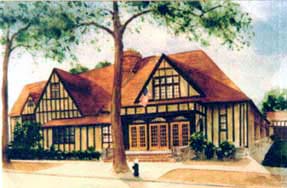 I wasn’t Jerry West, but I wasn’t embarrassing either, so I worked on it. Day after day, week after week, I practiced shooting basketballs. When the three o’clock bell rang at school, I would race over to The Community House, hoping to be the first one in the gym. So one afternoon, out of breath from running the five blocks from school carrying all my schoolbooks, I arrived at the empty Community House. It seemed like I had achieved my goal of being the first to arrive, but something made me stop outside the front door. Whoever opened the building for the afternoon session had left the keys in the door. There were maybe thirty keys on a huge metal ring, probably the keys to every door inside the building. Without a moment’s hesitation, looking both ways to make sure no one saw me do it, I snatched the keys from the front door and slipped them into my pocket. I had no idea what I would do with them, but something told me that having these keys was to my benefit.
I wasn’t Jerry West, but I wasn’t embarrassing either, so I worked on it. Day after day, week after week, I practiced shooting basketballs. When the three o’clock bell rang at school, I would race over to The Community House, hoping to be the first one in the gym. So one afternoon, out of breath from running the five blocks from school carrying all my schoolbooks, I arrived at the empty Community House. It seemed like I had achieved my goal of being the first to arrive, but something made me stop outside the front door. Whoever opened the building for the afternoon session had left the keys in the door. There were maybe thirty keys on a huge metal ring, probably the keys to every door inside the building. Without a moment’s hesitation, looking both ways to make sure no one saw me do it, I snatched the keys from the front door and slipped them into my pocket. I had no idea what I would do with them, but something told me that having these keys was to my benefit.
 The Community House was open from 3 to 5 in the afternoons, and 7 to 9 in the evenings. From 5 to 7, with Mr. Wonderly, who was the manager, and the colored custodian both out having dinner, the building would be empty, and available for solitary exploration. I hung around in the park across the street, and saw Mr. Wonderly and the custodian make their meal-time exits. It was now or never, so I slipped the key into the front door, and entered the empty building. One by one I began
The Community House was open from 3 to 5 in the afternoons, and 7 to 9 in the evenings. From 5 to 7, with Mr. Wonderly, who was the manager, and the colored custodian both out having dinner, the building would be empty, and available for solitary exploration. I hung around in the park across the street, and saw Mr. Wonderly and the custodian make their meal-time exits. It was now or never, so I slipped the key into the front door, and entered the empty building. One by one I began  opening all the inside doors using my new set of keys: the office, the equipment room which was filled with basketballs, baseball bats, catcher’s masks, badminton racquets, and every imaginable form of sports apparatus, the trophy cabinet, the storage room, the boxing gym, the swimming pool, and finally the locker rooms. I hesitated outside the girl’s locker room, wondering whether this act was a matter for the confessional, and rationalized to myself that I was not a sinner, I was an explorer. So I opened the door. It was pretty much the same as the boy’s
opening all the inside doors using my new set of keys: the office, the equipment room which was filled with basketballs, baseball bats, catcher’s masks, badminton racquets, and every imaginable form of sports apparatus, the trophy cabinet, the storage room, the boxing gym, the swimming pool, and finally the locker rooms. I hesitated outside the girl’s locker room, wondering whether this act was a matter for the confessional, and rationalized to myself that I was not a sinner, I was an explorer. So I opened the door. It was pretty much the same as the boy’s 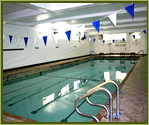 locker room. There were lockers, benches, a bathroom, a shower room, and the same combined odors of disinfectant, and chlorine from the pool. Above one row of lockers were six casement windows, each about three feet wide and six feet high, and covered with many layers of paint to insure privacy. I wondered where these windows were relative to the outside of the building, so I slipped out the back door and reconnoitered. There was a kind of drainage or ventilation pit with cement walls about six feet deep along the side of the building and inside this pit were all six windows, painted over and ignored. It occurred to me that an enterprising young man who scraped tiny viewing holes in the paint on the inside of the windows might gain visual access to the entire girl’s locker room from the privacy of this drainage pit. Yikes.
locker room. There were lockers, benches, a bathroom, a shower room, and the same combined odors of disinfectant, and chlorine from the pool. Above one row of lockers were six casement windows, each about three feet wide and six feet high, and covered with many layers of paint to insure privacy. I wondered where these windows were relative to the outside of the building, so I slipped out the back door and reconnoitered. There was a kind of drainage or ventilation pit with cement walls about six feet deep along the side of the building and inside this pit were all six windows, painted over and ignored. It occurred to me that an enterprising young man who scraped tiny viewing holes in the paint on the inside of the windows might gain visual access to the entire girl’s locker room from the privacy of this drainage pit. Yikes.
So back inside, I climbed up on the row of lockers and did just that. Using the borrowed keys I scraped small slits, maybe an inch by a quarter inch in each one of the windows. There were now six viewing stations from which a commensurate number of anatomically curious young men could hopefully view the naked bodies of the girl’s swimming team. By the time I got home I was ten feet tall. I had just successfully completed a monumental achievement, and would be known from here on as a boy with guts and vision; a boy with the entrepreneurial foresight to use an opportunity to its  greatest advantage. If there were a category of Nobel Prize for felonious mischief, King Gustav himself would be handing me the trophy, and shaking my hand. Maybe I should write him a letter explaining my triumph. My next step would be to select five friends who could keep a secret.
greatest advantage. If there were a category of Nobel Prize for felonious mischief, King Gustav himself would be handing me the trophy, and shaking my hand. Maybe I should write him a letter explaining my triumph. My next step would be to select five friends who could keep a secret.
The next day I gathered together a carefully selected group and explained the situation. Jimmy, Chipps Page, Billy Beggs, and the Bullock twins, (Stephen and Stuart) seemed the likeliest candidates so, after discussing strategy, we agreed to meet in the drainage pit at 7pm. There was to be no verbal communication in the pit. Absolute quiet was necessary for success. All discussion was to done by hand signals. At the appointed hour, like little ninjas on a mission, the six of us silently dropped down into the drainage pit, and slowly approached the tiny holes in the paint. And there they were. To our almost uncontrollable joy, the entire girls swimming team was walking around in varying degrees of undress. Diane Montgomery, Betty Welsh, Joan Roberts, Peggy Wainwright, all naked and, since the six of us were hidden in our subterranean vantage point, we could look at them as long as we wanted. And I did this. This remarkable achievement was all mine. I would be a king among boys. I could feel the tension in the great hall in Stockholm, as King 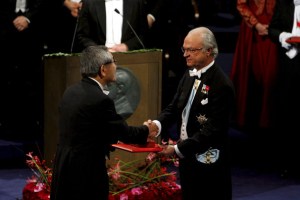 Gustav opened the envelope. “And for achievement in felonious mischief, this year’s award goes to……”, the room is hushed. “…..Shaun Costello, the young man from Forest Hills, whose keen interest in anatomy, and willingness to share his discoveries with his peers has changed the outlook of the young men of his community”. I couldn’t wipe the smile off my face. Before going home, the six of us swore an oath of absolute secrecy. If word were to get out, it would be the end of the greatest opportunity any of us had experienced. No one could know what we did tonight. We agreed to meet the next night at the same time, and went home.
Gustav opened the envelope. “And for achievement in felonious mischief, this year’s award goes to……”, the room is hushed. “…..Shaun Costello, the young man from Forest Hills, whose keen interest in anatomy, and willingness to share his discoveries with his peers has changed the outlook of the young men of his community”. I couldn’t wipe the smile off my face. Before going home, the six of us swore an oath of absolute secrecy. If word were to get out, it would be the end of the greatest opportunity any of us had experienced. No one could know what we did tonight. We agreed to meet the next night at the same time, and went home.
A little before seven, the next evening, I noticed Jimmy and Billy Beggs sitting on the Community House Lawn, under a tree. They seemed sad and disoriented, and wouldn’t respond when I asked them what was wrong, so I slipped through the bushes and approached our sacred viewing site. About fifty feet from the pit I noticed a huge cloud of blue/gray smoke, and as I came closer I could hear the giggling and guffawing of a crowd of boys, and to my absolute horror, there in our blessed pit, where the tender nakedness of our female neighbors had been so generously revealed only 24 hours before, were about twenty of the teenage jerks who hung out at the Sutton Hall Pharmacy; Howie Clary, Brian McKenna, Bill Conroy, and some kids I had never seen before. The same morons who beat each other up for amusement, not to mention laying the whup on kids they referred to as kike mother fuckers because they couldn’t think of anything else to do with themselves. And here they were, defiling this hallowed ground, where I had experienced my greatest achievement as a human being; moaning and  laughing and smoking Lucky’s and making way too much noise to go undetected for very long. I was shattered. In my short time on earth I had never experienced such disappointment. What about King Gustav? What about my Nobel Prize? What about our oath of secrecy? Somebody had obviously squealed. Chipps Page was always sucking up to the older guys, but I couldn’t accuse him because I had no proof. So I got out of there before the situation turned to disaster and, as I turned the corner onto Greenway North, I could see the flashing red lights from the approaching police cars. Six or seven of the teenage morons were apprehended and
laughing and smoking Lucky’s and making way too much noise to go undetected for very long. I was shattered. In my short time on earth I had never experienced such disappointment. What about King Gustav? What about my Nobel Prize? What about our oath of secrecy? Somebody had obviously squealed. Chipps Page was always sucking up to the older guys, but I couldn’t accuse him because I had no proof. So I got out of there before the situation turned to disaster and, as I turned the corner onto Greenway North, I could see the flashing red lights from the approaching police cars. Six or seven of the teenage morons were apprehended and 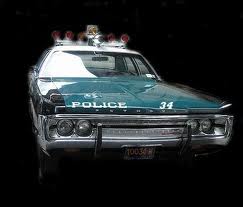 returned by the police to the welcoming arms of their angry parents for familial disposition, which I suppose was some small compensation for my loss. But for that one fateful night I was a King among my peers. I had achieved something never thought possible. For the first time in my childhood I had experienced success beyond my wildest dream, followed by crushing disappointment.
returned by the police to the welcoming arms of their angry parents for familial disposition, which I suppose was some small compensation for my loss. But for that one fateful night I was a King among my peers. I had achieved something never thought possible. For the first time in my childhood I had experienced success beyond my wildest dream, followed by crushing disappointment.
*
© 2007 Shaun Costello
WAKING THE DEAD

WAKING THE DEAD
By Shaun Costello
This story is excerpted from my childhood memoir
THE LAST TIME I SAW JESUS
Surviving God and Elvis in the time of ‘Duck and Cover’
Promotion to the Fifth Grade at Our Lady Queen of Martyrs School produced no noticeable changes in my day-to-day life, other than having a new teacher, and being a year older. The school, the kids, and the neighborhood seemed to go on as before. I was sitting in a booth at the Sutton Hall Pharmacy, sipping cokes after school with Beth Neilsen, Soomi Esses, Kevin James, and that know-it-all weasel Richard O’Leary. I had no money so Beth generously offered to share her lemon coke with me. Beth was the smartest and prettiest girl in school and, for a reason totally beyond my comprehension, treated me like I was human. At this point in my little life puberty was still only a rumor. Boys and girls rarely socialized, and paid little attention to each other, but Beth was different. She always said hello when our paths crossed, and made small talk that I never attempted to avoid.
 Anyway, probably as punishment for sins of past lifetimes, the four of us sat there listening to O’Leary’s insufferable diatribe on traitors in America. It seemed that President Eisenhower was a card carrying member of the communist party. So was J. Edgar Hoover. O’Leary knew this to be a fact because his father told him, and his father was always right. Not only that, but Douglas Mac Arthur, the hero of the Philippines in WWII, was now living in Moscow teaching the Russians how to destroy America in WWIII, which would begin in the Fall of 1956. “Real Americans”, claimed O’Leary, “knew about this stuff”.
Anyway, probably as punishment for sins of past lifetimes, the four of us sat there listening to O’Leary’s insufferable diatribe on traitors in America. It seemed that President Eisenhower was a card carrying member of the communist party. So was J. Edgar Hoover. O’Leary knew this to be a fact because his father told him, and his father was always right. Not only that, but Douglas Mac Arthur, the hero of the Philippines in WWII, was now living in Moscow teaching the Russians how to destroy America in WWIII, which would begin in the Fall of 1956. “Real Americans”, claimed O’Leary, “knew about this stuff”.
Just before I was ready to kill myself, I looked out the window and saw two kids being chased down the Street by an old man who was swinging his cane at them. They stopped, turned, and shot him with their Weegee water pistols, and the chase resumed. Finally the old man gave up and headed for the front door of the drug store. This was Mr. Nocky, the neighborhood lunatic. No one knew where he came from or where he lived. He was just there, and was often the victim of the cruelty of children. As he passed our booth I spoke up, “Hello Mr. Nocky”. He stopped, scanning the occupants of our booth. “Sasay, sasay, it’s not nice to fool Mr. Nocky’ he replied, as I knew he would. “Just saying hello Mr. Nocky”. “Well, that’s different then. Sasay, sasay, Mr. Nocky went to the Staunton Military Academy, in the beautiful Shenandoah Valley of Virginia. Not everyone went to Staunton, but Mr. Nocky did. And Mr. Nocky always used a Trojan. There are many brands of rubbers, but science has proven Trojan to be the most effective”. He wandered over to the counter mumbling, “Sasay, sasay” to himself, and by the time he took a stool his daily cup of tea was waiting for him.
Mr. Nocky’s interruption blessedly put the kibosh on O’Leary’s oration and, taking advantage of this event, the group happily disbanded. I lingered outside for a few minutes talking with Kevin James, who invited me to come over to his house the following Saturday, and then made my way home. The next day Kevin James was not in school. There was immediate speculation as to the cause of his absence. Mumps, measles, strep throat, flu, anything was possible. Grim and depressing as always, Vincent Averna was sure it was polio. Suddenly, Mother Superior appeared at the door to our classroom and  the kids jumped to their feet chirping in unison, “Good morning Mother Superior”. She addressed the class. “Children, you’ve probably noticed that Mr. James is absent this morning. It is my sad duty to inform you that last night his father was called to God’s bosom”. The whispers began:
the kids jumped to their feet chirping in unison, “Good morning Mother Superior”. She addressed the class. “Children, you’ve probably noticed that Mr. James is absent this morning. It is my sad duty to inform you that last night his father was called to God’s bosom”. The whispers began:
“What does that mean?”
“Dead”
“Dead?”
“Dead”
“Who?”
“Kevin’s dad, stupid”
“Kevin’s dad’s dead?”
“Duh”
“What did he die of?”
“How do I know?”
“What’s this bosom thing?”
‘That’s how nuns say people are dead”
“But what’s a bosom?”
“You’re pathetic”
Mother Superior continued, “On Thursday Sister Innocent will lead this entire class over to the funeral home, where Mr. James will lie in repose. You will say a rosary for the salvation of his immortal soul”. And she left.
So on Thursday afternoon, Sister Innocent marched her flock, all washed and dressed for the occasion, the nine or ten blocks to the Fox Funeral Home.  The place was owned by the Baxter family whose sons, Noel and Wayne, I had gotten to know playing basketball at the Community house. We were led into a large room with chairs arranged in rows facing the front where a large wooden casket sat on some kind of platform. The lid was open and, in the distance, you could see the pink, waxy looking face of Kevin’s dead father. Sister Innocent led the class in a rosary, after which we were to stand, in threes, at the side of the coffin, to view the body and pray that the soul of Mr. James would enjoy an eternity of happiness at the right side of God Almighty. Heaven was a very exclusive club. You had to be Catholic, and you had to be good, otherwise you spent eternity in an unpleasant alternative, roasting in the fires of hell. Protestants, Jews, Hindus, Moslems, Buddhists, regardless of their goodness, had no shot at salvation whatsoever, and were destined for the big barbecue. Heaven was a “Catholics only” venue. You had to be Protestant to be President, but you had to Catholic to rate heaven. Papal vengeance, I suppose.
The place was owned by the Baxter family whose sons, Noel and Wayne, I had gotten to know playing basketball at the Community house. We were led into a large room with chairs arranged in rows facing the front where a large wooden casket sat on some kind of platform. The lid was open and, in the distance, you could see the pink, waxy looking face of Kevin’s dead father. Sister Innocent led the class in a rosary, after which we were to stand, in threes, at the side of the coffin, to view the body and pray that the soul of Mr. James would enjoy an eternity of happiness at the right side of God Almighty. Heaven was a very exclusive club. You had to be Catholic, and you had to be good, otherwise you spent eternity in an unpleasant alternative, roasting in the fires of hell. Protestants, Jews, Hindus, Moslems, Buddhists, regardless of their goodness, had no shot at salvation whatsoever, and were destined for the big barbecue. Heaven was a “Catholics only” venue. You had to be Protestant to be President, but you had to Catholic to rate heaven. Papal vengeance, I suppose.
When it was my turn to stand next to the coffin, I was totally spooked. I had never seen a dead guy before, and was both terrified and fascinated. His skin was waxy and translucent and, although I had no experience at viewing the deceased, I can honestly say that he looked very life-like. I wondered what would happen if he suddenly sat up and started talking. Sixty kids would probably pee in their pants. When our respects had been properly paid, Sister marched us all back to school, and we went home from there.
 I stopped off at my friend Jimmy’s house to tell him about seeing the dead guy. It turned out that he had never seen one, but knew Wayne Baxter really well, and Wayne had once promised him that he would sneak him into the funeral home after hours and show him dead people. When confronted with his death-tour promise Baxter wanted a buck each for corpse viewing, which I thought was highway robbery, but Jimmy said he would lend me the dollar so we agreed. We rounded up Tommy Welstead and the Bullock twins, who agreed to the price, and the five of us were led by Wayne into the basement door of the funeral home.
I stopped off at my friend Jimmy’s house to tell him about seeing the dead guy. It turned out that he had never seen one, but knew Wayne Baxter really well, and Wayne had once promised him that he would sneak him into the funeral home after hours and show him dead people. When confronted with his death-tour promise Baxter wanted a buck each for corpse viewing, which I thought was highway robbery, but Jimmy said he would lend me the dollar so we agreed. We rounded up Tommy Welstead and the Bullock twins, who agreed to the price, and the five of us were led by Wayne into the basement door of the funeral home.
The place was closed from five to seven so that the employees could eat dinner, so we were alone with the deceased. After walking us through all the viewing rooms, where waxy bodies were displayed in open coffins, Wayne took us downstairs where he said they did the dirty work. There was a large tiled room where three naked bodies were lying on metal tables. All were elderly, two men and one woman. Their eyes were closed, and their mouths were open, and they had rubber tubes sticking into holes in their skin. There was an overwhelming smell of chemicals, but the bodies themselves had no  odor. Wayne told us that they were in the process of being embalmed, and that there wasn’t anything left inside them that could smell. Tommy Welstead started poking one of them with his finger, and Wayne shouted, “Hey, no touching”. Suddenly Stephen Bullock ran for the bathroom to puke his guts out. Wayne, still in tour guide mode, showed us the prep room, where bodies were put when they arrived, but before they were embalmed. The room was refrigerated and locked with a huge latch on the outside of the door, and smelled so badly that it didn’t seem like you could be in there more than thirty seconds without losing your lunch. Wayne told us that the bodies smelled awful before they were embalmed.
odor. Wayne told us that they were in the process of being embalmed, and that there wasn’t anything left inside them that could smell. Tommy Welstead started poking one of them with his finger, and Wayne shouted, “Hey, no touching”. Suddenly Stephen Bullock ran for the bathroom to puke his guts out. Wayne, still in tour guide mode, showed us the prep room, where bodies were put when they arrived, but before they were embalmed. The room was refrigerated and locked with a huge latch on the outside of the door, and smelled so badly that it didn’t seem like you could be in there more than thirty seconds without losing your lunch. Wayne told us that the bodies smelled awful before they were embalmed.
Our tour was now over and, out on the street, we parted company with Wayne. The five of us walked in silence for a few minutes before we realized that there were only four. Tommy was missing. Stephen suggested that he probably ran home to puke, and didn’t want any of us to know. It sounded reasonable and, along with Jimmy, I stopped by the Welstead house to tease him about throwing up, but his mother said she hadn’t seen him in a few hours. I suddenly had a terrible feeling that somehow we had left Tommy inside the funeral home. Mrs. Welstead let us use her phone, so Jimmy looked up Baxter in the directory, and got Wayne on the phone. He told him what had happened and Wayne agreed to meet us at the basement door to the funeral home right away. The three of us looked all over the place and there was no sign of Tommy. We wandered around the basement for a while and suddenly Wayne turned white as a sheet and said, “Oh Jesus, did we lock him in the prep room?” We approached the prep room door, the one with the huge latch that could only be opened from the outside. Wayne opened the enormous door, and there was Tommy Welstead, his skin all blue from the cold, and the whole front of his shirt covered with vomit, breathing heavily with his mouth wide open, and his eyes as big as quarters. He ran past us and out the basement door, leaving pukey footprints as he went. We looked inside the prep room, and most of the floor was covered with the last few meals that Tommy had eaten. What a mess. Wayne said we’d better clean this up before his father found it, and Jimmy turned to him and said, “You made five bucks. You clean it up”. So the two of us left our tour guide to clean up the mess. We didn’t talk much on the way home. Dead people. Very creepy.
*
© 2007 Shaun Costello






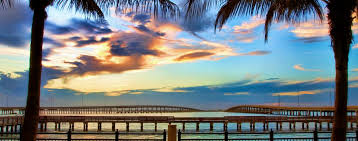









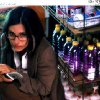














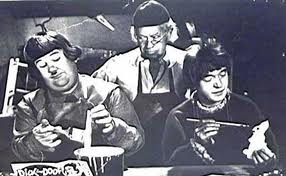


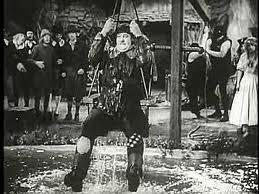
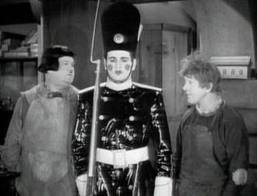
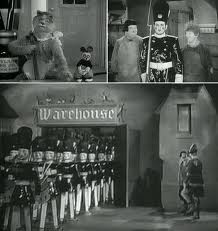




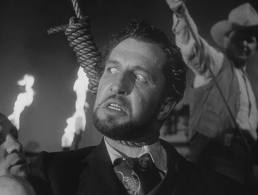


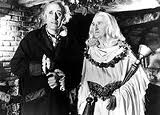

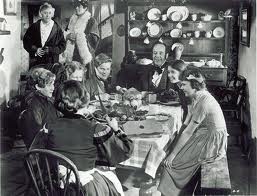
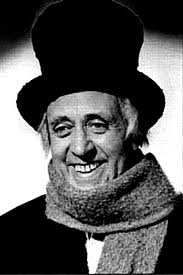




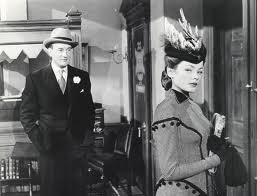
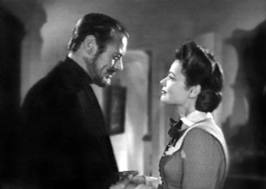
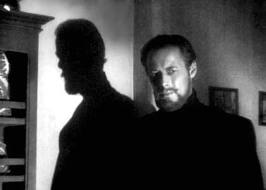

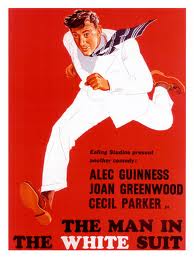

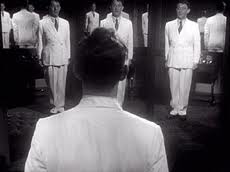








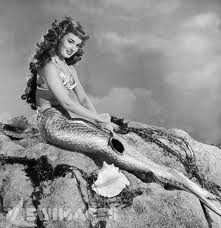


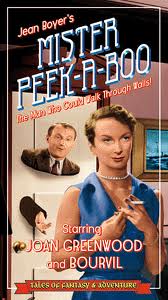
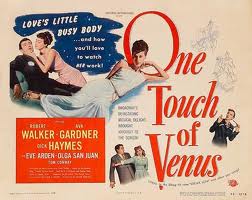




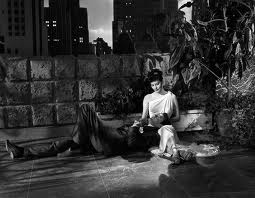
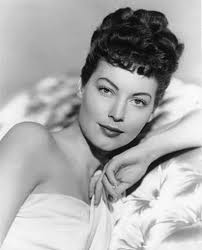










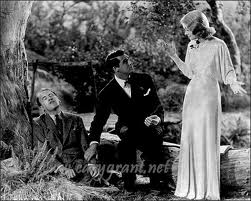
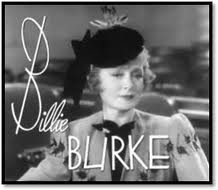




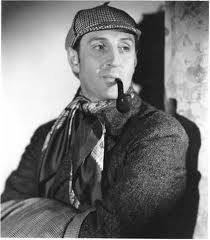















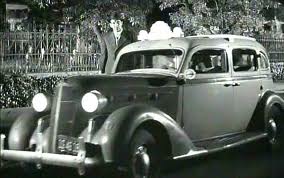

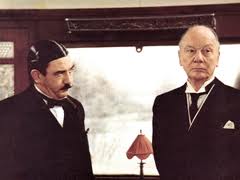


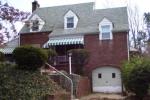














 lifetime career out of being the nephew of Mamie Eisenhower. He was one of those Washington political parasites who lived on the perks when his party was in power. The republicans still held the Whitehouse so Michael Gill was on the dole. It was never made clear to me exactly what Gill did, but from the look of him, I was certain that not all of it was legal.
lifetime career out of being the nephew of Mamie Eisenhower. He was one of those Washington political parasites who lived on the perks when his party was in power. The republicans still held the Whitehouse so Michael Gill was on the dole. It was never made clear to me exactly what Gill did, but from the look of him, I was certain that not all of it was legal. 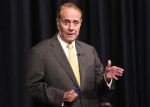
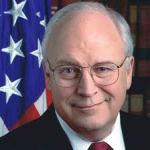
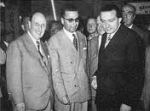


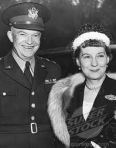 more Ike and Mamie pictures, that seem to go on forever. Next to the kitchen was a door that led to the stairway to the basement. I decided that Gill’s basement might be worth exploring, and I was right.
more Ike and Mamie pictures, that seem to go on forever. Next to the kitchen was a door that led to the stairway to the basement. I decided that Gill’s basement might be worth exploring, and I was right. 


